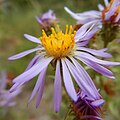User:Eewilson/sandbox 7
| This is a Wikipedia user page. This is not an encyclopedia article or the talk page for an encyclopedia article. |
| Symphyotrichum genus | |
|---|---|

| |
| Some Symphyotrichum species left–right, top–bottom are shown: S. carnerosanum, S. chilense, S. adnatum, S. lateriflorum, S. concolor, S. ericoides, S. defoliatum, S. ciliatum, S. novae-angliae. | |
| Scientific classification | |
| Kingdom: | Plantae |
| Clade: | Tracheophytes |
| Clade: | Angiosperms |
| Clade: | Eudicots |
| Clade: | Asterids |
| Order: | Asterales |
| Family: | Asteraceae |
| Subfamily: | Asteroideae |
| Tribe: | Astereae |
| Subtribe: | Symphyotrichinae |
| Genus: | Symphyotrichum |
THIS PAGE HAS DETAIL FROM BEFORE I PARED IT DOWN - TO BE USED IN ARTICLES
- cladogram needs Polyliguli change; maybe look into Turbinelli change
Symphyotrichum is a genus of flowering plants in the aster family (Asteraceae). It is the type genus of subtribe Symphyotrichinae of tribe Astereae. The species in the genus are native from subarctic North America to Chile, Argentina, and the Falkland Islands. One species has an extensive native distribution into eastern Eurasia.
The 96 species and 12 named hybrids are split into five subgenera: Ascendentes, comprising two allopolyploid species with putative parents crossing subgenera; Astropolium, with ten species mostly of South American origin; Chapmaniana, a monotypic taxon; Symphyotrichum, with three sections containing 64 species including nine hybrids; and, Virgulus, with four sections containing 31 species including three hybrids.
List conventions[edit]
To go directly to the list: § Species list
- Etymology
If the species epithet is based on a Latin word and not a derivative of a name, the translation to English from Wiktionary is given with a link. If the term is not available in Wiktionary, another source will be used and cited. If the epithet is named for a person or location, the name of the person or location is given and source cited.
- Chromosome counts (DNA)
Chromosome counts, when known, are labeled DNA in the Taxonomy column for each species. The base number of chromosomes is given as x = N, where N is the number of individual unique chromosomes in a single set.[a] Also shown is the ploidy, the number of complete sets of unique chromosomes in the cell nucleus for the species,[b] labeled using the following terms: diploid, triploid, tetraploid, pentaploid, hexaploid, septaploid, octaploid, decaploid, and duodecaploid.[c]
In literature, such as Flora of North America North of Mexico (FNA), the ploidy of a species is often written using the value 2n representing the total number of individual chromosomes in the nucleus. For example, Symphyotrichum boreale has a base number of 8 (eight unique chromosomes), written x = 8,[1] with diploid, tetraploid, hexaploid, and octaploid types written 2n = 16, 32, 48, 64.[2] Thus, individual specimens of Symphyotrichum boreale have been found with 2 (diploid), 4 (tetraploid), 6 (hexaploid), and 8 (octaploid) sets of its 8 chromosomes.
- Conservation statuses
-
NatureServe conservation categories Conservation status GX Presumed Extinct (0 species) GH Possibly Extinct (0 species) G1 Critically Imperiled (3 species) G2 Imperiled (9 species) G3 Vulnerable (7 species) G4 Apparently Secure (21 species) G5 Secure (35 species) Other categories GNA Not Applicable (8 species) GNR Not Ranked (0 species) NL Not listed (25 species)
-
IUCN Red List categories Conservation status EX Extinct (0 species) EW Extinct in the wild (0 species) CR Critically Endangered (0 species) EN Endangered (0 species) VU Vulnerable (0 species) NT Near threatened (2 species) LC Least concern (7 species) Other categories DD Data deficient (0 species) NE Not evaluated (0 species)
Explain conservation statuses - Species without a Canadian or US presence are not found in NatureServe.
As of August 2021[update].
Conservation column abbreviations:
- NatureServe conservation status (NS)
- IUCN Red List (IUCN 3.1)
- Committee on the Status of Endangered Wildlife in Canada (COSEWIC)
- Canada Species at Risk Act (SARA)
- CNPS Inventory of Rare and Endangered Plants of California (CNPS)
NatureServe conservation status (NS) - Of the species listed on this page. Valid species only. Rounded statuses. NatureServe puts hybrids under GNA. Hybrids not listed by NatureServe are in the NL count.
Note: Only NatureServe Global status are given, and only for species. GNR includes Not ranked, i.e. not yet assessed, or possibly unaccepted names. NL Not listed is not a NatureServe category but is used to represent those left out of any global status ranking
3 GNR that were not valid species names but synonyms for subspecies, so since they weren't valid, 0 is in the table. All values are only for accepted and valid species names
Talk about the IUCN a bit and that only 9 are in their DB at all.
Others - COSEWIC and CNPS
- Environmental indicators
Explain C-value and its limitations (e.g., not all areas have them)
Excluding those in non-native C-values always from this source:[3]
Explain Wetland Indicator Status Rating (for North American/US plants)
WIS in the table
Wetland indicator status always from this source:[4]
Classification[edit]
Classification of Symphyotrichum[edit]
Subtribe Symphyotrichinae contains six genera. In addition to Symphyotrichum, these are Almutaster, Ampelaster, Canadanthus, Psilactis,[5] and Sanrobertia,[6] with Symphyotrichum being the largest at 96 species and 12 named hybrids. The cladogram presented here is based on a combination of molecular and morphological data reported by Luc Brouillet et al. in 2009,[7] David R. Morgan and Blake Holland in 2012,[5] and Guy L. Nesom in 2018.[6]
| |||||||||||||||||||||||||||||||||||||||
Cladogram references
|
Classification within Symphyotrichum[edit]
Brouillet et al. 2009, p. 12[7] [8]
Symphyotrichum has five generally accepted subgenera with some variation among sections and subsections. The subgenera here are accepted by Brouillet et al. 2006 and Semple. Brouillet et al. 2006 only informally treat sections within subgenus Virgulus but do accept the shown sections within subgenus Symphyotrichum. Their sections, both formal and informal, are used here. Semple groups the species similarly but with additional segregation of species into sections, subsections, and some series. Those are shown with a dotted line. OTHER SOURCES, TOO NESOM 2018;[9] nesom 1994 for carnerosanum.[10]
Brouillet et al. 2006 informally gives subsections within section Symphyotrichum: "Subsections have been recognized within sect. Symphyotrichum. They are not treated formally here. Subsectional phylogeny is mostly unresolved.
Semple subsections within section Symphyotrichum: Semple segregates S. turbinellum within its own section Turbinelli. S. carnerosanum is not on his list. He also segregates S. novae-angliae within its own Virgulus section Polyliguli, and several species within section Grandiflori subsection Mexicanae.[11] The latter is shown here with additions by Nesom 2018.[9]
Species classification[edit]
-
Symphyotrichum subg. Chapmaniana subg. Astropolium subg. Virgulus sect. Ericoidei sect. Patentes subsect. Brachyphylli subsect. Patentes sect. Grandiflori subsect. Mexicanae subsect. Grandiflori sect. Polyliguli sect. Concolores subg. Ascendentes subg. Symphyotrichum sect. Conyzopsis sect. Occidentales sect. Turbinelli sect. Symphyotrichum subsect. Dumosi subsect. Heterophylli ser. Concinni ser. Cordifolii subsect. Porteriani subsect. Symphyotrichum ser. Punicei ser. Symphyotrichum
Species list[edit]
- S. adnatum
- S. × amethystinum
- S. anomalum
- S. anticostense
- S. ascendens
- S. × batesii
- S. bimater
- S. boreale
- S. bullatum
- S. burgessii
- S. campestre
- S. carnerosanum
- S. chapmanii
- S. chihuahuense
- S. chilense
- S. ciliatum
- S. ciliolatum
- S. × columbianum
- S. concolor
- S. cordifolium
- S. defoliatum
- S. depauperatum
- S. drummondii
- S. dumosum
- S. eatonii
- S. elliottii
- S. ericoides
- S. estesii
- S. eulae
- S. falcatum
- S. fendleri
- S. × finkii
- S. firmum
- S. foliaceum
- S. fontinale
- S. frondosum
- S. georgianum
- S. glabrifolium
- S. graminifolium
- S. grandiflorum
- S. × gravesii
- S. greatae
- S. hallii
- S. hendersonii
- S. hintonii
- S. jessicae
- S. laeve
- S. lanceolatum
- S. lateriflorum
- S. laurentianum
- S. lentum
- S. leone
- S. × longulum
- S. lucayanum
- S. martii
- S. molle
- S. moranense
- S. nahanniense
- S. novae-angliae
- S. novi-belgii
- S. oblongifolium
- S. ontarionis
- S. oolentangiense
- S. parviceps
- S. patagonicum
- S. patens
- S. peteroanum
- S. phlogifolium
- S. pilosum
- S. plumosum
- S. porteri
- S. potosinum
- S. praealtum
- S. pratense
- S. prenanthoides
- S. priceae
- S. puniceum
- S. purpurascens
- S. pygmaeum
- S. racemosum
- S. regnellii
- S. retroflexum
- S. rhiannon
- S. robynsianum
- S. × salignum
- S. schaffneri
- S. × schistosum
- S. sericeum
- S. shortii
- S. simmondsii
- S. spathulatum
- S. × subgeminatum
- S. subspicatum
- S. subulatum
- S. × tardiflorum
- S. tenuifolium
- S. tradescantii
- S. trilineatum
- S. turbinellum
- S. turneri
- S. undulatum
- S. urophyllum
- S. vahlii
- S. × versicolor
- S. walteri
- S. welshii
- S. × woldenii
- S. yukonense
| Names and photo | Taxonomy | Distribution and habitat | Conservation |
|---|---|---|---|
| Scientific name with link to the species article (hybrids do not have their own articles) and common names of the species with a photo, if available | Abbreviated species name, author citation, basionym, year of species description, name etymology, base chromosome number and chromosome counts (DNA), and list of infraspecies | Distribution map with a footnoted description, short description of species' habitats, and wetland indicator statuses (WIS) for United States species that have them | Conservation statuses from all of the following that apply: C‑vals |
Subgenus Chapmaniana[edit]
Subgenus Chapmaniana (Semple) Semple[12]
| Names and photo | Taxonomy | Distribution and habitat | Conservation |
|---|---|---|---|
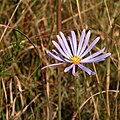 Savanna aster[13] |
S. chapmanii (Torr. & A.Gray) Semple & Brouillet[14] Basionym: Aster chapmanii[15] |

|
G2 NatureServe Reasons for rating include frequent habitat drainage for recreation and agriculture and a restricted range. Possibly extirpated in Alabama. Global conservation status was last reviewed on 10 November 1997[update].[20] |
Contents • Alphabetical species index • Legend
Subgenus Astropolium[edit]
Subgenus Astropolium (Nutt.) Semple[12]
| Names and photo | Taxonomy | Distribution and habitat | Conservation |
|---|---|---|---|
 |
S. glabrifolium (DC.) G.L.Nesom[21] Basionym: Erigeron glabrifolius[22] |
 |
NL IUCN 3.1 |
 |
S. graminifolium (Spreng.) G.L.Nesom[26] |

|
NL IUCN 3.1 |
 |
S. martii (Baker) G.L.Nesom[30] |
 |
NL IUCN 3.1 |
|
S. patagonicum (Cabrera) G.L.Nesom[35] |
 |
NL IUCN 3.1 | |
 |
S. peteroanum (Phil.) G.L.Nesom[39] |

|
NL IUCN 3.1 |
 Santa Rita Mountain aster[44] |
S. potosinum (A.Gray) G.L.Nesom[45] |

|
G2 NatureServe |
 |
S. regnellii (Baker) G.L.Nesom[51] |
 |
NL IUCN 3.1 |
 Annual saltmarsh aster, eastern annual saltmarsh aster[54] |
S. subulatum (Michx.) G.L.Nesom[55] Five varieties[60]
|

|
G5 NatureServe |
 Perennial saltmarsh aster[64] |
S. tenuifolium (L.) G.L.Nesom[65] Two varieties[68]
|

|
G5 NatureServe |
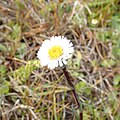 Margarita, marsh daisy[70] |
S. vahlii (Gaudich.) G.L.Nesom[71] Two varieties[71]
|

|
NL IUCN 3.1 |
Contents • Alphabetical species index • Legend
Subgenus Virgulus[edit]
Subgenus Virgulus (Raf.) G.L.Nesom[76]
Section Ericoidei[edit]
Section Ericoidei (Torr. & A.Gray) G.L.Nesom[77]
| Names and photo | Taxonomy | Distribution and habitat | Conservation |
|---|---|---|---|
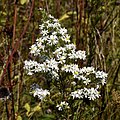 White heath aster[78] |
S. ericoides (L.) G.L.Nesom[79] Two varieties[79]
|

|
G5 NatureServe |
 Western heath aster, white prairie aster[86] |
S. falcatum (Lindl.) G.L.Nesom[87] Two varieties[87]
|

|
G5 NatureServe |
Contents • Alphabetical species index • Legend
Section Patentes[edit]
Section Patentes (Torr. & A.Gray) G.L.Nesom[77]
Subsection Brachyphylli[edit]
Subsection Brachyphylli (Torr. & A.Gray) G.L.Nesom[77]
| Names and photo | Taxonomy | Distribution and habitat | Conservation |
|---|---|---|---|
 Scaleleaf aster[94] |
S. adnatum (Nutt.) G.L.Nesom[95] |

|
G4 NatureServe |
 Walter's aster[99] |
S. walteri (Alexander) G.L.Nesom[100] |

|
G4 NatureServe |
Contents • Alphabetical species index • Legend
Subsection Patentes[edit]
| Names and photo | Taxonomy | Distribution and habitat | Conservation |
|---|---|---|---|
 Georgia aster[105] |
S. georgianum (Alexander) G.L.Nesom[106] |
 |
G3 NatureServe |
 Late purple aster, spreading aster[110] |
S. patens (Aiton) G.L.Nesom[111] Three varieties[111]
|

|
G5 NatureServe |
 Thinleaf late purple aster[117] |
S. phlogifolium (Muhl. ex Willd.) G.L.Nesom[118] |

|
G5 NatureServe |
Contents • Alphabetical species index • Legend
Section Grandiflori[edit]
Section Grandiflori (Torr. & A.Gray) G.L.Nesom[123]
Subsection Mexicanae[edit]
Subsection Mexicanae G.L.Nesom[123]
| Names and photo | Taxonomy | Distribution and habitat | Conservation |
|---|---|---|---|
|
S. bimater (Standl. & Steyerm.) G.L.Nesom[124] |

|
NL IUCN 3.1 | |
|
S. chihuahuense G.L.Nesom[129] |

|
NL IUCN 3.1 | |
 |
S. hintonii (G.L.Nesom) G.L.Nesom[132] |

|
NL IUCN 3.1 |
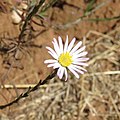 |
S. moranense (Kunth) G.L.Nesom[136] |

|
NL IUCN 3.1 |
|
S. purpurascens (Sch.Bip.) G.L.Nesom[141] |

|
NL IUCN 3.1 | |
 |
S. trilineatum (Sch.Bip. ex Klatt) G.L.Nesom[146] |
 |
NL IUCN 3.1 |
 |
S. turneri (S.D.Sundb. & A.G.Jones) G.L.Nesom[152] |

|
NL IUCN 3.1 |
Contents • Alphabetical species index • Legend
Subsection Grandiflori[edit]
Subsection Grandiflori (Torr. & A.Gray) G.L.Nesom[123]
| Names and photo | Taxonomy | Distribution and habitat | Conservation |
|---|---|---|---|
|
Symphyotrichum campestre
|
S. campestre (Nutt.) G.L.Nesom[157] |

|
G5 NatureServe |
|
Symphyotrichum estesii |
S. estesii Semple[162] |
|
G1 NatureServe |
 Fendler’s aster[166] |
S. fendleri (A.Gray) G.L.Nesom[167] |

|
G4 NatureServe |
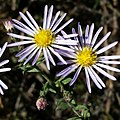 Florida water aster[172] |
S. fontinale (Alexander) G.L.Nesom[173] |

|
G3 NatureServe |
 Large-flowered aster[180] |
S. grandiflorum (L.) G.L.Nesom[181] |

|
G4 NatureServe |
 New England aster[185] |
S. novae-angliae (L.) G.L.Nesom[186] |

|
G5 NatureServe |
 Aromatic aster, oblong-leaved aster[190] |
S. oblongifolium (Nutt.) G.L.Nesom[191] |

|
G5 NatureServe |
 Pygmy aster[195] |
S. pygmaeum (Lindl.) Brouillet & Selliah[196] |

|
G4 NatureServe |
 Yukon aster[201] |
S. yukonense (Cronquist) G.L.Nesom[202] |

|
G3 NatureServe |
Contents • Alphabetical species index • Legend
Section Concolores[edit]
Section Concolores (Torr. & A.Gray) G.L.Nesom[207]
| Names and photo | Taxonomy | Distribution and habitat | Conservation |
|---|---|---|---|
 Eastern silver aster[208] |
S. concolor (L.) G.L.Nesom[209] Two varieties[209]
|

|
G5 NatureServe |
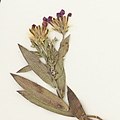 Pineland aster[216] |
S. lucayanum (Britton) G.L.Nesom[217] |

|
|
 |
S. plumosum (Small) Semple[221] |

|
G2 NatureServe |
 Barrens silky aster[226] |
S. pratense (Raf.) G.L.Nesom[227] |

|
G4 NatureServe |
 Western silvery aster[231] |
S. sericeum (Vent.) G.L.Nesom[232] |

|
G5 NatureServe |
Contents • Alphabetical species index • Legend
Subgenus Virgulus named hybrids[edit]
| Names and photo | Taxonomy | Distribution and habitat | Conservation |
|---|---|---|---|
|
Symphyotrichum × amethystinum  Amethyst aster[237] |
S. × amethystinum (Nutt.) G.L.Nesom[238] |

|
|
|
Symphyotrichum × batesii |
S. × batesii (Rydb.) G.L.Nesom[243] |
 |
NL NatureServe |
|
Symphyotrichum × columbianum |
S. × columbianum (Piper) G.L.Nesom[250] |
 |
Contents • Alphabetical species index • Legend
Subgenus Ascendentes[edit]
Subgenus Ascendentes (Rydb.) Semple[12]
| Names and photo | Taxonomy | Distribution and habitat | Conservation |
|---|---|---|---|
 Long-leaved aster, intermountain aster, western aster[255] |
S. ascendens (Lindl.) G.L.Nesom[256] |

|
G5 NatureServe |
 San Bernardino aster[261] |
S. defoliatum (Parish) G.L.Nesom[262] |
 |
G2 NatureServe |
Contents • Alphabetical species index • Legend
Subgenus Symphyotrichum[edit]
Subgenus Symphyotrichum
Section Conyzopsis[edit]
Section Conyzopsis (Torr. & A.Gray) G.L.Nesom[270]
| Names and photo | Taxonomy | Distribution and habitat | Conservation |
|---|---|---|---|
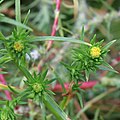 Rayless annual aster, rayless alkali aster[271] |
S. ciliatum (Ledeb.) G.L.Nesom[272] |

|
G5 NatureServe |
 Short-rayed alkali aster[278] |
S. frondosum (Nutt.) G.L.Nesom[279] |

|
G4 NatureServe |
 Gulf of St. Lawrence aster[283] |
S. laurentianum (Fernald) G.L.Nesom[284] |
 |
G1 NatureServe |
Contents • Alphabetical species index • Legend
Section Occidentales[edit]
Section Occidentales (Rydb.) G.L.Nesom[270]
| Names and photo | Taxonomy | Distribution and habitat | Conservation |
|---|---|---|---|
 Pacific aster, common California aster[288] |
S. chilense (Nees) G.L.Nesom[289] |

|
G5 NatureServe |
 Eaton's aster[295] |
S. eatonii (A.Gray) G.L.Nesom[296] |
 |
G5 NatureServe |
 Alpine leafybract aster, leafy aster, leafy-bracted aster[302] |
S. foliaceum (Lindl. ex DC.) G.L.Nesom[303] |
 |
G5 NatureServe |
 Greata's aster[309] |
S. greatae (Parish) G.L.Nesom[310] |

|
G2 NatureServe |
 Hall's aster[316] |
S. hallii (A.Gray) G.L.Nesom[317] |

|
G4 NatureServe |
 Henderson's aster[325] |
S. hendersonii (Fernald) G.L.Nesom[326] |

|
G4 NatureServe |
 Jessica's aster[332] |
S. jessicae (Piper) G.L.Nesom[333] |

|
G2 NatureServe |
 Suisun marsh aster[338] |
S. lentum (Greene) G.L.Nesom[339] |
 |
G2 NatureServe |
 Soft aster[346] |
S. molle (Rydb.) G.L.Nesom[347] |

|
G3 NatureServe |
 Western mountain aster[352] |
S. spathulatum (Lindl.) G.L.Nesom[353] Three varieties[356]
|

|
G5 NatureServe |
 Douglas's aster[358] |
S. subspicatum (Nees) G.L.Nesom[359] |

|
G5 NatureServe |
Contents • Alphabetical species index • Legend
Section Symphyotrichum[edit]
Section Symphyotrichum
Subsection Dumosi[edit]
Subsection Dumosi (Torr. & A.Gray) G.L.Nesom[364] Nesom places S. carnerosanum within subsect. Dumosi.[10] Semple does not have it placed.[11]
| Names and photo | Taxonomy | Distribution and habitat | Conservation |
|---|---|---|---|
 Rush aster, slender white aster, northern bog aster[2] |
S. boreale (Torr. & A.Gray) Á.Löve & D.Löve[365] |

|
G5 NatureServe |
|
S. bullatum (Klatt) G.L.Nesom[370] |
 |
NL IUCN 3.1 | |
 |
S. burgessii (Britton) G.L.Nesom[375] |

|
NL IUCN 3.1 |
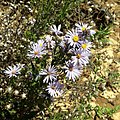 |
S. carnerosanum (S.Watson) G.L.Nesom[380] |

|
NL IUCN 3.1 |
 Bushy aster[386] |
S. dumosum (L.) G.L.Nesom[387] |

|
G5 NatureServe |
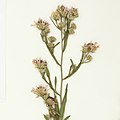 Eula's aster[391] |
S. eulae (Shinners) G.L.Nesom[392] |

|
G4 NatureServe |
 Lance-leaved aster, panicled aster, white panicled aster[397] |
S. lanceolatum (Willd.) G.L.Nesom[398] Five varieties[401]
|

|
G5 NatureServe |
 Calico aster, white woodland aster, side-flowering aster[405] |
S. lateriflorum (L.) Á.Löve & D.Löve[406] |

|
G5 NatureServe |
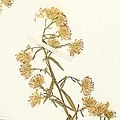 |
S. leone (Britton) G.L.Nesom[410] |

|
NL IUCN 3.1 |
 Nahanni aster[414] |
S. nahanniense (Cody) Semple[415] |

|
G3 NatureServe |
 Ontario aster, bottomland aster[421] |
S. ontarionis (Wiegand) G.L.Nesom[422] Two varieties[422]
|

|
G5 NatureServe |
 Willowleaf aster, willow aster[428] |
S. praealtum (Poir.) G.L.Nesom[429] |

|
G5 NatureServe |
 Small white aster, smooth white oldfield aster[434] |
S. racemosum (Elliott) G.L.Nesom[435] |

|
G4 NatureServe |
|
S. schaffneri (S.D.Sundb. & A.G.Jones) G.L.Nesom[439] |
 |
NL IUCN 3.1 | |
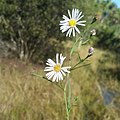 Simmonds' aster[444] |
S. simmondsii (Small) G.L.Nesom[445] |

|
G4 NatureServe |
 Tradescant's aster, shore aster[450] |
S. tradescantii (L.) G.L.Nesom[451] |

|
G4 NatureServe |
 Welsh's aster[455] |
S. welshii (Cronquist) G.L.Nesom[456] |

|
G2 NatureServe |
Contents • Alphabetical species index • Legend
Subsection Heterophylli[edit]
Subsection Heterophylli (Nees) Semple[8]
Series Concinni[edit]
Series Concinni (Nees) Semple[8]
| Names and photo | Taxonomy | Distribution and habitat | Conservation |
|---|---|---|---|
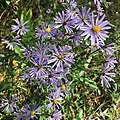 Smooth aster[460] |
S. laeve (L.) Á.Löve & D.Löve[461] Four varieties[465]
|

|
G5 NatureServe |
 Azure aster, skyblue aster[469] |
S. oolentangiense (Riddell) G.L.Nesom[470] |

|
G5 NatureServe |
Contents • Alphabetical species index • Legend
Series Cordifolii[edit]
Series Cordifolii (G.Don in Loudon) Semple[8]
| Names and photo | Taxonomy | Distribution and habitat | Conservation |
|---|---|---|---|
 Manyray aster[475] |
S. anomalum (Engelm.) G.L.Nesom[476] |

|
G4 NatureServe |
 Lindley's aster, fringed blue aster[480] |
S. ciliolatum (Lindl.) Á.Löve & D.Löve[481] |

|
G5 NatureServe |
 Heartleaf aster, common blue wood aster[485] |
S. cordifolium (L.) G.L.Nesom[486] |

|
G5 NatureServe |
 Drummond's aster[490] |
S. drummondii (Lindl.) G.L.Nesom[491] Two varieties[495]
|
 |
G5 NatureServe |
 Short's aster[498] |
S. shortii (Lindl.) G.L.Nesom[499] |

|
G5 NatureServe |
 Wavyleaf aster[504] |
S. undulatum (L.) G.L.Nesom[505] |

|
G5 NatureServe |
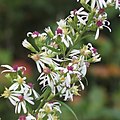 White arrowleaf aster, arrowleaf aster[509] |
S. urophyllum (Lindl.) G.L.Nesom[510] |

|
G4 NatureServe |
Contents • Alphabetical species index • Legend
Subsection Porteriani[edit]
Subsection Porteriani (Rydb.) G.L.Nesom[515]
| Names and photo | Taxonomy | Distribution and habitat | Conservation |
|---|---|---|---|
 Serpentine aster, starved aster[516] |
S. depauperatum (Fernald) G.L.Nesom[517] |

|
G2 NatureServe |
 Smallhead aster, small white aster[522] |
S. parviceps (E.S.Burgess) G.L.Nesom[523] |

|
G4 NatureServe |
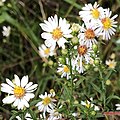 Hairy aster, frost aster, hairy white oldfield aster[527] |
S. pilosum (Willd.) G.L.Nesom[528] Two varieties[531]
|

|
G5 NatureServe |
 Porter's aster, smooth white aster[533] |
S. porteri (A.Gray) G.L.Nesom[534] |

|
G3 NatureServe |
 Miss Price's aster,[540] Price's aster, lavender oldfield aster[541] |
S. priceae (Britton) G.L.Nesom[542] |

|
G4 NatureServe |
Contents • Alphabetical species index • Legend
Subsection Symphyotrichum[edit]
Subsection Symphyotrichum
Series Punicei[edit]
Series Punicei (House) Semple[8]
| Names and photo | Taxonomy | Distribution and habitat | Conservation |
|---|---|---|---|
 Elliott's aster[546] |
S. elliottii (Torr. & A.Gray) G.L.Nesom[547] |

|
G4 NatureServe |
 Glossy-leaved aster[553] |
S. firmum (Nees) G.L.Nesom[554] |

|
G5 NatureServe |
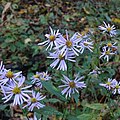 Crookedstem aster[558] |
S. prenanthoides (Muhl. ex Willd.) G.L.Nesom[559] |

|
G4 NatureServe |
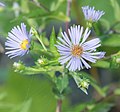 Purplestem aster, red-stemmed aster, swamp aster[564] |
S. puniceum (L.) Á.Löve & D.Löve[565] Two varieties[568]
|

|
G5 NatureServe |
 Rhiannon's aster, Buck Creek aster[571] |
S. rhiannon Weakley & Govus[572] |

|
G1 NatureServe |
Contents • Alphabetical species index • Legend
Series Symphyotrichum[edit]
Series Symphyotrichum
| Names and photo | Taxonomy | Distribution and habitat | Conservation |
|---|---|---|---|
 Anticosti aster[578] |
S. anticostense (Fernald) G.L.Nesom[579] |

|
G3 NatureServe |
 New York aster[584] |
S. novi-belgii (L.) G.L.Nesom[585] Four varieties[585]
|

|
G5 NatureServe |
 Rigid whitetop aster[591] |
S. retroflexum (Lindl.) G.L.Nesom[592] |

|
G4 NatureServe |
 Robyn's aster[596] |
S. robynsianum (J.Rousseau) Brouillet & Labrecque[597] |

|
G5 NatureServe |
 Prairie aster[602] |
S. turbinellum (Lindl.) G.L.Nesom[603] |

|
G4 NatureServe |
Contents • Alphabetical species index • Legend
Subgenus Symphyotrichum named hybrids[edit]
| Names and photo | Taxonomy | Distribution and habitat | Conservation |
|---|---|---|---|
|
Symphyotrichum × finkii |
S. × finkii (Rydb.) G.L.Nesom[607] |

|
|
|
Symphyotrichum × gravesii  Graves' aster[614] |
S. × gravesii (E.S.Burgess) G.L.Nesom[615] |

|
|
|
Symphyotrichum × longulum  |
S. × longulum (E.Sheld.) G.L.Nesom[621] |

|
|
|
Symphyotrichum × salignum  |
S. × salignum (Willd.) G.L.Nesom[627] |
 |
NL NatureServe |
|
Symphyotrichum × schistosum  |
S. × schistosum (E.S.Steele) G.L.Nesom[631] |

|
|
|
Symphyotrichum × subgeminatum  |
S. × subgeminatum (Fernald) G.L.Nesom[638] |

|
|
|
Symphyotrichum × tardiflorum  |
S. × tardiflorum (L.) Greuter, M.V.Agab. & Wagenitz[644] |

|
NL NatureServe |
|
Symphyotrichum × versicolor 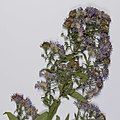 Late Michaelmas daisy grin |
S. × versicolor (Willd.) G.L.Nesom[648] |
 |
|
|
Symphyotrichum × woldenii  |
S. × woldenii (Rydb.) G.L.Nesom[652] |
 |
Contents • Alphabetical species index • Legend
Notes[edit]
- ^ Derived content from Polyploidy version 04:50 7 August 2021. See that page's history for attribution.
- ^ Derived content from Ploidy version 02:18 5 August 2021. See that page's history for attribution.
- ^ Derived content from Polyploidy version 04:50 7 August 2021. See that page's history for attribution.
- ^ Symphyotrichum chapmanii is found in primarily the Apalachicola River drainage basin.[18] Alabama counties — Geneva and Houston; Florida counties — Alachua, Bay, Calhoun, Franklin, Gulf, Jackson, Liberty, Okaloosa, Santa Rosa, St. Lucie, Wakulla, Walton, and Washington.[19]
- ^ Symphyotrichum glabrifolium is found in the Argentine provinces of Mendoza, Neuquén, Río Negro, and Santa Cruz;[25] and central and south Chile.[21]
- ^ Symphyotrichum patagonicum is found in the Argentine provinces of Chubut, Mendoza, Neuquén, and Santa Cruz.[38]
- ^ Symphyotrichum potosinum is found in the Huachuca Mountains in Cochise County, Arizona[49] and the Mexican states of Aguascalientes, Chihuahua, Durango, Guanajuato, Guerrero, Hidalgo, Jalisco, México State, Michoacan, Oaxaca, Puebla, San Luis Potosí, Sonora, Veracruz, and Zacatecas.[50]
- ^ Symphyotrichum regnellii is found in the Argentine provinces of Corrientes and Misiones;[43] and in west-central, southeast, and south Brazil.[51]
- ^ Symphyotrichum subulatum is native to Argentina; Bahamas; Belize; Bolivia; Brazil; Canada — New Brunswick and Ontario; Chile; Colombia; Costa Rica; Cuba; Dominican Republic; Ecuador; Guatemala; Haiti; Honduras; Jamaica; Mexico; Nicaragua; Paraguay; Peru; Uruguay; US — Alabama, Arizona, Arkansas, California, Connecticut, Delaware, Florida, Georgia, Illinois, Indiana, Kansas, Louisiana, Maine, Maryland, Massachusetts, Michigan, Mississippi, Nebraska, Nevada, New Hampshire, New Jersey, New Mexico, New York, North Carolina, Ohio, Oklahoma, Pennsylvania, Rhode Island, South Carolina, Tennessee, Texas, Utah, and Virginia; and, Venezuela. Also introduced worldwide.[55]
- ^ Symphyotrichum tenuifolium US distribution is in Alabama, Connecticut, Delaware, Florida, Georgia, Louisiana, Maine, Maryland, Massachusetts, Mississippi, New Hampshire, New Jersey, New York, North Carolina, Rhode Island, South Carolina, Texas, and Virginia.[65]
- ^ Symphyotrichum ericoides: Canada — Alberta, British Columbia, Manitoba, Northwest Territories, Ontario, Québec, and Saskatchewan; Mexico — Coahuila and Nuevo León; US — Arizona, Arkansas, Colorado, Connecticut, Delaware, District of Columbia, Idaho, Illinois, Indiana, Iowa, Kansas, Maine, Maryland, Massachusetts, Michigan, Minnesota, Mississippi, Missouri, Montana, Nebraska, New Jersey, New Mexico, New York, North Dakota, Ohio, Oklahoma, Oregon, Pennsylvania, Rhode Island, South Dakota, Texas, Utah, Vermont, Virginia, Washington, West Virginia, Wisconsin, and Wyoming.[79]
- ^ Symphyotrichum falcatum: Canada — Alberta, British Columbia, Manitoba, Northwest Territories, Ontario, Saskatchewan, and Yukon;[87] Mexico — Chihuahua, Coahuila, Durango, Jalisco, Nuevo León, and Sonora;[91] US — Alaska, Arizona, Colorado, Idaho, Illinois, Iowa, Kansas, Minnesota, Missouri, Montana, Nebraska, New Mexico, North Dakota, Oklahoma, South Dakota, Texas, Utah, Wisconsin, and Wyoming.[87]
- ^ Symphyotrichum adnatum: Bahamas; US — Alabama, Florida, Georgia, Louisiana, and Mississippi.[95]
- ^ Symphyotrichum walteri: US — Florida, Georgia, North Carolina, and South Carolina.[100]
- ^ Symphyotrichum georgianum: US — Alabama, Florida, Georgia, North Carolina, and South Carolina.[106]
- ^ Symphyotrichum patens: US — Alabama, Arkansas, Connecticut, Delaware, District of Columbia, Florida, Georgia, Illinois, Indiana, Kansas, Kentucky, Louisiana, Maine, Maryland, Massachusetts, Mississippi, Missouri, New Hampshire, New Jersey, New York, North Carolina, Ohio, Oklahoma, Pennsylvania, Rhode Island, South Carolina, Tennessee, Texas, Virginia, and West Virginia.[111]
- ^ Symphyotrichum phlogifolium: US — Alabama, Connecticut, Delaware, District of Columbia, Georgia, Indiana, Kentucky, Maryland, Massachusetts, New York, North Carolina, Ohio, Pennsylvania, Rhode Island, South Carolina, Tennessee, Virginia, and West Virginia.[118]
- ^ Symphyotrichum bimater distribution: Guatemala; Mexico — Chiapas and Oaxaca.[128]
- ^ Symphyotrichum chihuahuense distribution: Mexico – Chihuahua and Durango[131]
- ^ Using Google Translate.
- ^ Symphyotrichum moranense distribution: Mexico — Aguascalientes, Chihuahua, Distrito Federal, Durango, Guanajuato, Guerrero, Hidalgo, Jalisco, México, Michoacán, Morelos, Nayarit, Oaxaca, Puebla, Querétaro, San Luis Potosí, Sinaloa, Tlaxcala, Veracruz, and Zacatecas.[139]
- ^ Symphyotrichum purpurascens distribution: Guatemala – Huehuetenango Department; Mexico — Chiapas, Distrito Federal, Guanajuato, Guerrero, Hidalgo, México, Nuevo León, Oaxaca, Puebla, San Luis Potosí, Tamaulipas, and Tlaxcala.[131]
- ^ Symphyotrichum trilineatum distribution: Guatemala — Huehuetenango Department and Totonicapán Department; Mexico — Chiapas, Chihuahua, Distrito Federal, Durango, Guanajuato, Guerrero, Hidalgo, México, Michoacán, Nuevo León, Oaxaca, Puebla, San Luis Potosí, Tamaulipas, Tlaxcala, and Veracruz.[150]
- ^ Symphyotrichum campestre distribution: Canada – Alberta and British Columbia; US — California, Colorado, Idaho, Montana, Nevada, Oregon, Washington, and Wyoming.[157]
- ^ Elevation in the May Prairie State Natural Area.
- ^ Undescribed until 2019.
- ^ Symphyotrichum fendleri distribution: US — Colorado, Kansas, Nebraska, New Mexico, Oklahoma, and Texas.[167]
- ^ Symphyotrichum fontinale distribution: Georgia — Grady County; Florida counties — Alachua, Citrus, Collier, Dixie, Lee, Liberty, Marion, Miami-Dade, Monroe, Pasco, and Taylor.[177][178]
- ^ Symphyotrichum novae-angliae native distribution in green: Canada — Manitoba, New Brunswick, Nova Scotia, Ontario, and Québec; US — Alabama, Arkansas, Colorado, Connecticut, Delaware, District of Columbia, Georgia, Illinois, Indiana, Iowa, Kansas, Kentucky, Maine, Maryland, Massachusetts, Michigan, Minnesota, Mississippi, Missouri, Nebraska, New Hampshire, New Jersey, New Mexico, New York, North Carolina, North Dakota, Ohio, Oklahoma, Pennsylvania, Rhode Island, South Carolina, South Dakota, Tennessee, Virginia, West Virginia, and Wisconsin. Introduced North American distribution in blue: US — Montana, Oregon, Utah, Washington, and Wyoming.[185]
- ^ Symphyotrichum oblongifolium: Mexico – Coahuila; US — Alabama, Arkansas, Colorado, Illinois, Indiana, Iowa, Kansas, Kentucky, Maryland, Minnesota, Mississippi, Missouri, Montana, Nebraska, New Mexico, North Carolina, North Dakota, Ohio, Oklahoma, Pennsylvania, South Dakota, Tennessee, Texas, Virginia, West Virginia, Wisconsin, and Wyoming.[190]
- ^ Symphyotrichum concolor US distribution — Alabama, Delaware, Florida, Georgia, Kentucky, Louisiana, Maryland, Massachusetts, Mississippi, New Jersey, New York, North Carolina, Rhode Island, South Carolina, Tennessee, and Virginia.[209]
- ^ Symphyotrichum lucayanum is endemic to the island of Grand Bahama.[216]
- ^ Symphyotrichum plumosum US distribution — Florida counties: Calhoun, Franklin, Gadsden, Gulf, Jackson, Leon, Liberty, and Wakulla.[225]
- ^ Symphyotrichum pratense distribution in the US — Alabama, Arkansas, Florida, Georgia, Kentucky, Louisiana, Mississippi, Tennessee, Texas, and Virginia.[227]
- ^ Symphyotrichum sericeum native distribution: Canada – Manitoba and Ontario; US — Arkansas, Georgia, Indiana, Iowa, Kansas, Michigan, Minnesota, Missouri, Nebraska, North Dakota, Ohio, Oklahoma, South Dakota, Tennessee, Texas, and Wisconsin.[232]
- ^ Canada — Ontario; US — Colorado, Connecticut, Illinois, Indiana, Iowa, Kentucky, Maryland, Massachusetts, Minnesota, Missouri, Nebraska, New Jersey, New York, North Dakota, Pennsylvania, Rhode Island, Vermont, Washington, and Wisconsin.[238]
- ^ Symphyotrichum ascendens native distribution is as follows: Canada — Alberta, British Columbia, and Saskatchewan; Canada — Arizona, California, Colorado, Idaho, Montana, Nevada, New Mexico, North Dakota, Oregon, Utah, Washington, and Wyoming.[256]
- ^ Symphyotrichum defoliatum is endemic to the San Gabriel Mountains, San Bernardino Mountains, and Peninsular Ranges of California.[267]
- ^ Canada — Alberta, British Columbia, Manitoba, New Brunswick, Northwest Territories, Ontario, Québec, Saskatchewan, and Yukon; China — China North-Central, China Southeast, Heilongjiang, Inner Mongolia, Jilin, Liaoning, Manchuria, and Xinjiang; Kazakhstan; Kyrgyzstan; Mongolia; Russia — Altai Republic, Krasnoyarsk Krai, Primorsky Krai, Sakhalin, Tuva, Western Siberia, and Zabaykalsky Krai; Tadzhikistan; US — Alaska, Colorado, Idaho, Illinois, Indiana, Iowa, Kansas, Maine, Michigan, Minnesota, Missouri, Montana, Nebraska, New York, North Dakota, Ohio, Oklahoma, Pennsylvania, South Dakota, Utah, Washington, Wisconsin, and Wyoming; and, Uzbekistan.[272]
- ^ Canada – British Columbia; Mexico – Baja California; US — Arizona, California, Colorado, Idaho, Nevada, New Mexico, Oregon, Utah, Washington, and Wyoming.[278]
- ^ New Brunswick, Prince Edward Island, and Québec.[283]
- ^ Canada – British Columbia; US — Washington, Oregon, California,[288] including the Channel Islands.[293]
- ^ Canada — Alberta, British Columbia, and Saskatchewan; US — Arizona, California, Colorado, Idaho, Montana, Nevada, New Mexico, Oregon, Utah, Washington, and Wyoming.[296]
- ^ As Symphyotrichum bracteolatum.
- ^ In FNA as Symphyotrichum cusickii.[307]
- ^ Canada — Alberta and British Columbia; US — Alaska, Arizona, California, Colorado, Idaho, Montana, Nevada, New Mexico, Oregon, Utah, Washington, and Wyoming.[303]
- ^ Oregon and Washington – Puget Sound region, Willamette Valley, outliers in Columbia Gorge and central Washington.[316] County distribution: Oregon — Benton, Clackamas, Douglas, Hood River, Josephine, Lane, Linn, Marion, Multnomah, Polk, and Wasco; Washington — Clark, King, Okanogan, and Skagit.[323]
- ^ US — California, Idaho, Montana, Oregon, and Washington.[325]
- ^ Idaho and Washington – Palouse River and Clearwater River (Idaho) drainages;[332] Idaho counties — Clearwater, Idaho, Latah, LeWIS, and Nez Perce; Washington counties — Columbia, Walla Walla, and Whitman.[336]
- ^ California counties: Contra Costa, Napa, Sacramento, San Joaquin, Solano, and Yolo.[343]
- ^ Canada — Alberta and British Columbia; Mexico — Baja California; US — California, Colorado, Idaho, Montana, Nevada, New Mexico, Oregon, Utah, Washington, and Wyoming.[353]
- ^ Canada — Alberta and British Columbia; US — Alaska, California, Idaho, Montana, Oregon, and Washington.[359]
- ^ Canada — Alberta, British Columbia, Manitoba, New Brunswick, Newfoundland, Northwest Territories, Nova Scotia, Nunavut, Ontario, Prince Edward Island, Québec, Saskatchewan, and Yukon; US — Alaska, Colorado, Idaho, Illinois, Indiana, Iowa, Massachusetts, Michigan, Minnesota, Montana, Nebraska, New Hampshire, New Jersey, New York, North Dakota, Ohio, Pennsylvania, South Dakota, Vermont, Washington, West Virginia, Wisconsin, and Wyoming.[365]
- ^ Excluding northwest Mexico.[370]
- ^ Provinces of Cuba with 2011 names — Artemisa, Cienfuegos, La Habana, Matanzas, Mayabeque, Pinar del Río, Sancti Spíritus, and Villa Clara.[378]
- ^ Mexico – Coahuila, Nuevo León, and Tamaulipas.[380]
- ^ Canada — New Brunswick and Ontario; US — Alabama, Arkansas, Connecticut, Delaware, District of Columbia, Florida, Georgia, Illinois, Indiana, Iowa, Kentucky, Louisiana, Maine, Maryland, Massachusetts, Michigan, Mississippi, Missouri, New Hampshire, New Jersey, New York, North Carolina, Ohio, Oklahoma, Pennsylvania, Rhode Island, South Carolina, Tennessee, Texas, Virginia, West Virginia, and Wisconsin.[387]
- ^ S. eulae distribution in Texas by county: Bexar, Brazoria, Brazos, Burleson, Collin, Cooke, Dallas, Denton, Ellis, Gonzales, Hardin, Haskell, Henderson, Hill, Hood, Hopkins, Hunt, Jack, Johnson, Kaufman, Limestone, Navarro, Nueces, Parker, Rockwall, San Saba, Smith, Tarrant, Travis, Walker, Waller, Washington, and Wise.[395]
- ^ Canada — Alberta, British Columbia, Manitoba, New Brunswick, Newfoundland, Northwest Territories, Nova Scotia, Ontario, Prince Edward Island, Québec, and Saskatchewan;[398] Mexico — Baja California, Chihuahua, and Sonora;[402] US — Alabama, Arizona, Arkansas, California, Colorado, Connecticut, District of Columbia, Florida, Georgia, Idaho, Illinois, Indiana, Iowa, Kansas, Kentucky, Louisiana, Maine, Maryland, Massachusetts, Michigan, Minnesota, Mississippi, Missouri, Montana, Nebraska, Nevada, New Hampshire, New Jersey, New Mexico, New York, North Carolina, North Dakota, Ohio, Oklahoma, Oregon, Pennsylvania, Rhode Island, South Carolina, South Dakota, Tennessee, Texas, Utah, Vermont, Virginia, Washington, West Virginia, Wisconsin, and Wyoming.[398]
- ^ Canada — Manitoba, New Brunswick, Nova Scotia, Ontario, Prince Edward Island, and Québec; Mexico – Veracruz; US — Alabama, Arkansas, Connecticut, Delaware, District of Columbia, Florida, Georgia, Illinois, Indiana, Iowa, Kansas, Kentucky, Louisiana, Maine, Maryland, Massachusetts, Michigan, Minnesota, Mississippi, Missouri, Nebraska, New Hampshire, New Jersey, New York, North Carolina, Ohio, Oklahoma, Pennsylvania, Rhode Island, South Carolina, South Dakota, Tennessee, Texas, Vermont, Virginia, West Virginia, and Wisconsin.[406]
- ^ Symphyotrichum nahanniense has been found at seven hot springs locations within the Nahanni National Park Reserve in Northwest Territories, Canada. The general location of those hot springs is outlined in green on this map.[418]
- ^ Canada – Ontario and Québec; US — Alabama, Illinois, Indiana, Iowa, Kansas, Kentucky, Louisiana, Michigan, Minnesota, Mississippi, Missouri, Nebraska, New York, North Carolina, Oklahoma, Pennsylvania, South Dakota, Tennessee, Texas, Vermont, and Wisconsin.[422]
- ^ Canada – Ontario; Mexico — Chihuahua, Coahuila, and Nuevo León; US — Alabama, Arkansas, Connecticut, Delaware, District of Columbia, Florida, Illinois, Indiana, Iowa, Kansas, Kentucky, Louisiana, Maine, Maryland, Massachusetts, Michigan, Minnesota, Mississippi, Missouri, Nebraska, New Hampshire, New Jersey, New York, Ohio, Oklahoma, Pennsylvania, Rhode Island, South Dakota, Tennessee, Texas, Virginia, West Virginia, and Wisconsin.[428]
- ^ US — Alabama, Arkansas, Connecticut, Delaware, District of Columbia, Florida, Georgia, Illinois, Indiana, Iowa, Kentucky, Louisiana, Maine, Maryland, Massachusetts, Missouri, New Jersey, New York, North Carolina, Ohio, Oklahoma, Pennsylvania, Rhode Island, South Carolina, Tennessee, Texas, Vermont, Virginia, West Virginia, and Wisconsin.[434]
- ^ Mexico – Puebla and Veracruz.[443]
- ^ US — Florida, Georgia, North Carolina, and South Carolina.[448]
- ^ Canada — New Brunswick, Newfoundland, Nova Scotia, and Québec; US — Maine, Massachusetts, New Hampshire, New Jersey, New York, Rhode Island, and Vermont.[451]
- ^ US — Arizona, Idaho, Montana, Utah, and Wyoming.[456]
- ^ Canada — Alberta, British Columbia, Manitoba, Ontario, Saskatchewan, and Yukon[461] (introduced in New Brunswick and Québec);[467] Mexico – Coahuila;[466] US — Alabama, Arkansas, California, Colorado, Connecticut, Delaware, District of Columbia, Florida, Georgia, Idaho, Illinois, Indiana, Iowa, Kansas, Kentucky, Louisiana, Maine, Maryland, Massachusetts, Michigan, Minnesota, Mississippi, Missouri, Montana, Nebraska, Nevada, New Hampshire, New Jersey, New Mexico, New York, North Carolina, North Dakota, Ohio, Pennsylvania, Rhode Island, South Carolina, South Dakota, Tennessee, Texas, Utah, Vermont, Virginia, Washington, West Virginia, Wisconsin, and Wyoming.[461]
- ^ Canada — Ontario;[470] Mexico — Coahuila;[469] US — Alabama, Arkansas, Florida, Georgia, Illinois, Indiana, Iowa, Kansas, Kentucky, Louisiana, Michigan, Minnesota, Mississippi, Missouri, Nebraska, New York, Ohio, Oklahoma, Pennsylvania, South Dakota, Tennessee, Texas, and Wisconsin.[470]
- ^ US — Arkansas, Illinois, Kansas, Missouri, and Oklahoma.[475]
- ^ Canada — Alberta, British Columbia, Manitoba, New Brunswick, Newfoundland, Northwest Territories, Nova Scotia, Ontario, Québec, Saskatchewan, and Yukon; US — Illinois, Maine, Massachusetts, Michigan, Minnesota, Montana, New Hampshire, New York, North Dakota, South Dakota, Vermont, Wisconsin, and Wyoming.[481]
- ^ Canada — Manitoba, New Brunswick, Nova Scotia, Ontario, Prince Edward Island, and Québec; US — Alabama, Arkansas, Connecticut, District of Columbia, Georgia, Illinois, Indiana, Iowa, Kentucky, Maine, Maryland, Massachusetts, Michigan, Minnesota, Missouri, Nebraska, New Hampshire, New Jersey, New York, North Carolina, Ohio, Oklahoma, Pennsylvania, Rhode Island, South Carolina, South Dakota, Tennessee, Vermont, Virginia, West Virginia, and Wisconsin.[486]
- ^ Mexico – Coahuila;[496] US — Alabama, Arkansas, Georgia, Illinois, Indiana, Iowa, Kansas, Kentucky, Louisiana, Maryland, Michigan, Minnesota, Mississippi, Missouri, Nebraska, Ohio, Oklahoma, Pennsylvania, Tennessee, Texas, West Virginia, and Wisconsin.[491]
- ^ Canada – Ontario; US — Alabama, Arkansas, Florida, Georgia, Illinois, Indiana, Iowa, Kentucky, Maryland, Michigan, Minnesota, Mississippi, North Carolina, Pennsylvania, Tennessee, Virginia, West Virginia, and Wisconsin.[499]
- ^ Canada – Nova Scotia and Ontario; US — Alabama, Connecticut, Delaware, District of Columbia, Florida, Georgia, Illinois, Indiana, Kentucky, Louisiana, Maine, Maryland, Massachusetts, Mississippi, New Hampshire, New Jersey, New York, North Carolina, Ohio, Pennsylvania, Rhode Island, South Carolina, Tennessee, Vermont, Virginia, and West Virginia.[505]
- ^ Canada — Ontario; US — Alabama, Arkansas, Florida, Georgia, Illinois, Indiana, Iowa, Kansas, Kentucky, Maine, Maryland, Massachusetts, Michigan, Minnesota, Mississippi, Missouri, Nebraska, New Jersey, New York, North Carolina, North Dakota, Ohio, Oklahoma, Pennsylvania, South Carolina, Tennessee, Vermont, Virginia, West Virginia, and Wisconsin.[510]
- ^ US — Maryland (Baltimore[520] and Cecil[521] Counties); North Carolina (Granville County);[520] and, Pennsylvania (Chester, Delaware, and Lancaster Counties).[521]
- ^ US — Arkansas, Illinois, Iowa, Kansas, Missouri, and Oklahoma.[523]
- ^ Canada — Ontario and Québec; US — Alabama, Arkansas, Connecticut, Delaware, District of Columbia, Florida, Georgia, Illinois, Indiana, Iowa, Kansas, Kentucky, Maine, Maryland, Massachusetts, Michigan, Minnesota, Mississippi, Missouri, Nebraska, New Hampshire, New Jersey, New York, North Carolina, Ohio, Oklahoma, Pennsylvania, Rhode Island, South Carolina, South Dakota, Tennessee, Vermont, Virginia, West Virginia, and Wisconsin.[531]
- ^ US — Colorado counties: Boulder, Douglas, El Paso, Gilpin, Jefferson, Larimer, Las Animas, and Teller; New Mexico counties: Harding and San Miguel; Wyoming counties: Albany, Carbon, and Laramie.[538]
- ^ US — Alabama, Georgia, Kentucky, and Tennessee.[542]
- ^ US Atlantic Coastal Plain — Alabama, Florida, Georgia, Louisiana, North Carolina, South Carolina, and Virginia.[546]
- ^ Canada — Alberta, Manitoba, Ontario, Saskatchewan; US — Georgia, Iowa, Michigan, Minnesota, Missouri, Nebraska, New York.[554]
- ^ Canada — Ontario; US — Connecticut, Delaware, District of Columbia, Illinois, Indiana, Iowa, Kentucky, Maryland, Massachusetts, Michigan, Minnesota, New Jersey, New York, North Carolina, Ohio, Pennsylvania, Virginia, West Virginia, and Wisconsin.[559]
- ^ Canada — Alberta, British Columbia, Labrador, Manitoba, New Brunswick, Newfoundland, Nova Scotia, Ontario, Prince Edward Island, Québec, and Saskatchewan; US — Alabama, Connecticut, Delaware, Georgia, Illinois, Indiana, Iowa, Louisiana, Maine, Maryland, Michigan, Minnesota, Mississippi, Missouri, Nebraska, New Hampshire, New Jersey, New York, North Carolina, North Dakota, Ohio, Pennsylvania, Rhode Island, South Carolina, South Dakota, Tennessee, Texas, Vermont, Virginia, West Virginia, and Wisconsin.[565]
- ^ "[A]n allopolyploid derivative of the cross between the calcareous fen species S. boreale and the widespread shore species S. novi-belgii."[578]
- ^ Canada – New Brunswick and Québec; US – Maine.[578]
- ^ Canada — Labrador, New Brunswick, Newfoundland, Nova Scotia, Prince Edward Island, and Québec; US — Connecticut, Maine, Maryland, Massachusetts, New Hampshire, New Jersey, New York, North Carolina, Pennsylvania, Rhode Island, South Carolina, Vermont, Virginia, and West Virginia.[585]
- ^ US — Blue Ridge Mountains[591] of Alabama, Georgia, North Carolina, South Carolina, Tennessee, and Virginia.[592]
- ^ Canada — Manitoba, Ontario, and Québec; US — Michigan, Minnesota, and Wisconsin.[597]
- ^ US — Primarily the Ozarks of Arkansas, Illinois, Iowa, Kansas, Louisiana, Missouri, Nebraska, and Oklahoma.[602]
- ^ The locations are from the USDA PLANTS Database with added county information from two sources. Iowa[607][610] — Fayette[248]; West Virginia — no county information[610]; Wisconsin — Eau Claire, Grant,[612] and Waupaca.[610]
- ^ US — Minnesota, New Jersey, New York, and Wisconsin.[621]
- ^ There is also an extensive presence of this hybrid in Europe and western Asia in the following countries: Assam, Austria, Baltic States, Belarus, Belgium, Bulgaria, Czechoslovakia, Denmark, Finland, France, Germany, Great Britain, Hungary, Ireland, Italy, Kazakhstan, Krym, Netherlands, Norway, Poland, Romania, Spain, Sweden, Switzerland, Tadzhikistan, Ukraine, Uzbekistan, and Yugoslavia.[627]
- ^ Canada — New Brunswick, Nova Scotia, and Québec.[644]
- ^ Austria; Belgium; Czech Republic; France; Germany; Great Britain; Hungary; Ireland; Italy; Madeira; Netherlands; Norway; Poland; Romania; Slovakia; Spain; Switzerland; Ukraine; and Yugoslavia.[648]
Citations[edit]
- ^ a b c d e f g h i j k l m n o p q Semple n.d.f.
- ^ a b c d Brouillet et al. 2006, Symphyotrichum boreale.
- ^ Freyman 2021.
- ^ CRREL 2018.
- ^ a b Morgan & Holland 2012, p. 818.
- ^ a b Nesom 2018a, p. 1.
- ^ a b Brouillet et al. 2009, p. 12.
- ^ a b c d e f Semple, Heard & Brouillet 2002.
- ^ a b Nesom 2018b, p. 8.
- ^ a b Nesom 1994, p. 204.
- ^ a b Semple 2021c.
- ^ a b c Semple, Heard & Brouillet 2002, p. 133.
- ^ a b c d Brouillet et al. 2006, Symphyotrichum chapmanii.
- ^ POWO 2021, Symphyotrichum chapmanii.
- ^ IPNI 2021, Symphyotrichum chapmanii.
- ^ IPNI 2021, Aster chapmanii.
- ^ Torrey & Gray 1841, p. 161.
- ^ Semple 2014a.
- ^ NRCS 2014c.
- ^ NatureServe 2021, Eurybia chapmanii.
- ^ a b c POWO 2021, Symphyotrichum glabrifolium.
- ^ IPNI 2021, Symphyotrichum glabrifolium.
- ^ IPNI 2021, Erigeron glabrifolius.
- ^ a b c d e f Semple n.d.b.
- ^ a b c Sancho & Ariza Espinar 2003, p. 10 as Aster glabrifolius.
- ^ a b POWO 2021, Symphyotrichum graminifolium.
- ^ IPNI 2021, Symphyotrichum graminifolium.
- ^ IPNI 2021, Conyza graminifolia.
- ^ Sancho & Ariza Espinar 2003, pp. 9–10 as Aster cabrerae.
- ^ POWO 2021, Symphyotrichum martii.
- ^ IPNI 2021, Symphyotrichum martii.
- ^ IPNI 2021, Aster martii.
- ^ Martius 1882.
- ^ a b Heiden 2020.
- ^ POWO 2021, Symphyotrichum patagonicum.
- ^ IPNI 2021, Symphyotrichum patagonicum.
- ^ IPNI 2021, Aster patagonicus.
- ^ a b c Sancho & Ariza Espinar 2003, pp. 10–11.
- ^ POWO 2021, Symphyotrichum peteroanum.
- ^ IPNI 2021, Symphyotrichum peteroanum.
- ^ IPNI 2021, Aster peteroanus.
- ^ Philippi 1894, p. 406.
- ^ a b c d e Sancho & Ariza Espinar 2003, p. 11.
- ^ a b c d Brouillet et al. 2006, Symphyotrichum potosinum.
- ^ POWO 2021, Symphyotrichum potosinum.
- ^ IPNI 2021, Symphyotrichum potosinum.
- ^ IPNI 2021, Aster potosinus.
- ^ Gray 1880.
- ^ a b c NatureServe 2021, Symphyotrichum potosinum.
- ^ Hassler 2021p.
- ^ a b c POWO 2021, Symphyotrichum regnellii.
- ^ IPNI 2021, Symphyotrichum regnellii.
- ^ IPNI 2021, Aster regnellii.
- ^ Brouillet et al. 2006, Symphyotrichum subulatum.
- ^ a b c POWO 2021, Symphyotrichum subulatum.
- ^ IPNI 2021, Symphyotrichum subulatum.
- ^ IPNI 2021, Aster subulatus.
- ^ Brouillet et al. 2006, Symphyotrichum subulatum vars. ligulatum, parviflorum, subulatum.
- ^ Brouillet et al. 2006, Symphyotrichum subulatum vars. elongatum, squamatum.
- ^ a b Brouillet et al. 2006, Symphyotrichum subulatum varieties.
- ^ a b NatureServe 2021, Symphyotrichum subulatum.
- ^ Maiz-Tome 2016a.
- ^ Species at Risk Act 2002b.
- ^ Brouillet et al. 2006, Symphyotrichum tenuifolium.
- ^ a b c POWO 2021, Symphyotrichum tenuifolium.
- ^ IPNI 2021, Symphyotrichum tenuifolium.
- ^ IPNI 2021, Aster tenuifolius.
- ^ a b c Brouillet et al. 2006, Symphyotrichum tenuifolium varieties.
- ^ NatureServe 2021, Symphyotrichum tenuifolium.
- ^ a b Hind & Strange 2019, p. 390.
- ^ a b c POWO 2021, Symphyotrichum vahlii.
- ^ IPNI 2021, Symphyotrichum vahlii.
- ^ IPNI 2021, Erigeron vahlii.
- ^ Nesom 1994, p. 210.
- ^ Hind & Strange 2019, pp. 387–390.
- ^ Nesom 1994, p. 272.
- ^ a b c Nesom 1994, p. 274.
- ^ Brouillet et al. 2006, Symphyotrichum ericoides.
- ^ a b c d e POWO 2021, Symphyotrichum ericoides.
- ^ IPNI 2021, Symphyotrichum ericoides.
- ^ IPNI 2021, Aster ericoides.
- ^ Semple 2014b.
- ^ Brouillet et al. 2006, Symphyotrichum ericoides var. ericoides.
- ^ Brouillet et al. 2006, Symphyotrichum ericoides varieties.
- ^ a b NatureServe 2021, Symphyotrichum ericoides.
- ^ Brouillet et al. 2006, Symphyotrichum falcatum.
- ^ a b c d e POWO 2021, Symphyotrichum falcatum.
- ^ IPNI 2021, Symphyotrichum falcatum.
- ^ IPNI 2021, Aster falcatus.
- ^ Semple 2014c.
- ^ Brouillet et al. 2006, Symphyotrichum falcatum var. commutatum.
- ^ Brouillet et al. 2006, Symphyotrichum falcatum varieties.
- ^ a b NatureServe 2021, Symphyotrichum falcatum.
- ^ a b c d Brouillet et al. 2006, Symphyotrichum adnatum.
- ^ a b c POWO 2021, Symphyotrichum adnatum.
- ^ IPNI 2021, Symphyotrichum adnatum.
- ^ IPNI 2021, Aster adnatus.
- ^ NatureServe 2021, Symphyotrichum adnatum.
- ^ a b c Brouillet et al. 2006, Symphyotrichum walteri.
- ^ a b c POWO 2021, Symphyotrichum walteri.
- ^ IPNI 2021, Symphyotrichum walteri.
- ^ IPNI 2021, Aster walteri.
- ^ Small 1933, pp. 1382–1383.
- ^ NatureServe 2021, Symphyotrichum walteri.
- ^ a b c Brouillet et al. 2006, Symphyotrichum georgianum.
- ^ a b c POWO 2021, Symphyotrichum georgianum.
- ^ IPNI 2021, Symphyotrichum georgianum.
- ^ IPNI 2021, Aster georgianus.
- ^ NatureServe 2021, Symphyotrichum georgianum.
- ^ Brouillet et al. 2006, Symphyotrichum patens.
- ^ a b c POWO 2021, Symphyotrichum patens.
- ^ IPNI 2021, Symphyotrichum patens.
- ^ IPNI 2021, Aster patens.
- ^ a b Brouillet et al. 2006, Symphyotrichum patens varieties.
- ^ NRCS 2014a.
- ^ NatureServe 2021, Symphyotrichum patens.
- ^ a b c Brouillet et al. 2006, Symphyotrichum phlogifolium.
- ^ a b c POWO 2021, Symphyotrichum phlogifolium.
- ^ IPNI 2021, Symphyotrichum phlogifolium.
- ^ IPNI 2021, Aster phlogifolius.
- ^ Jones 1983, p. 43.
- ^ NatureServe 2021, Symphyotrichum phlogifolium.
- ^ a b c Nesom 1994, p. 273.
- ^ POWO 2021, Symphyotrichum bimater.
- ^ IPNI 2021, Symphyotrichum bimater.
- ^ IPNI 2021, Aster bimater.
- ^ a b c d e Nesom 2018b, p. 1.
- ^ a b c Nesom 2018b, p. 6.
- ^ POWO 2021, Symphyotrichum chihuahuense.
- ^ IPNI 2021, Symphyotrichum chihuahuense.
- ^ a b c d e Nesom 2018b, p. 5.
- ^ POWO 2021, Symphyotrichum hintonii.
- ^ IPNI 2021, Symphyotrichum hintonii.
- ^ IPNI 2021, Aster hintonii.
- ^ a b c d e Nesom 2018b, p. 3.
- ^ POWO 2021, Symphyotrichum moranense.
- ^ IPNI 2021, Symphyotrichum moranense.
- ^ IPNI 2021, Aster moranensis.
- ^ a b c d e Nesom 2018b, p. 2.
- ^ a b Nesom 1994, p. 215.
- ^ POWO 2021, Symphyotrichum purpurascens.
- ^ IPNI 2021, Symphyotrichum purpurascens.
- ^ IPNI 2021, Aster purpurascens.
- ^ Nesom 2018b, p. 4.
- ^ Nesom 2018b, pp. 4–5.
- ^ a b POWO 2021, Symphyotrichum trilineatum.
- ^ IPNI 2021, Symphyotrichum trilineatum.
- ^ IPNI 2021, Aster trilineatus.
- ^ Morgan & Holland 2012, p. 825.
- ^ a b GBIF.org 2021b.
- ^ Nesom 1989.
- ^ POWO 2021, Symphyotrichum turneri.
- ^ IPNI 2021, Symphyotrichum turneri.
- ^ IPNI 2021, Aster moranensis var. turneri.
- ^ Sundberg & Jones 1986, p. 177.
- ^ a b c Brouillet et al. 2006, Symphyotrichum campestre.
- ^ a b c POWO 2021, Symphyotrichum campestre.
- ^ IPNI 2021, Symphyotrichum campestre.
- ^ IPNI 2021, Aster campestris.
- ^ a b NatureServe 2021, Symphyotrichum campestre.
- ^ a b Semple 2019b.
- ^ a b c Semple 2019a, p. 1.
- ^ Semple 2019a, p. 7.
- ^ Semple 2019a, pp. 1, 7, 9.
- ^ NatureServe 2021, Symphyotrichum estesii.
- ^ a b c Brouillet et al. 2006, Symphyotrichum fendleri.
- ^ a b c POWO 2021, Symphyotrichum fendleri.
- ^ IPNI 2021, Symphyotrichum fendleri.
- ^ IPNI 2021, Aster fendleri.
- ^ Kennedy 2021.
- ^ NatureServe 2021, Symphyotrichum fendleri.
- ^ a b Brouillet et al. 2006, Symphyotrichum fontinale.
- ^ POWO 2021, Symphyotrichum fontinale.
- ^ IPNI 2021, Symphyotrichum fontinale.
- ^ IPNI 2021, Aster fontinalis.
- ^ a b Semple 2019c.
- ^ GBIF.org 2021d.
- ^ SERNEC 2021.
- ^ NatureServe 2021, Symphyotrichum fontinale.
- ^ a b c Brouillet et al. 2006, Symphyotrichum grandiflorum.
- ^ a b POWO 2021, Symphyotrichum grandiflorum.
- ^ IPNI 2021, Symphyotrichum grandiflorum.
- ^ IPNI 2021, Aster grandiflorus.
- ^ NatureServe 2021, Symphyotrichum grandiflorum.
- ^ a b c d e Brouillet et al. 2006, Symphyotrichum novae-angliae.
- ^ POWO 2021, Symphyotrichum novae-angliae.
- ^ IPNI 2021, Symphyotrichum novae-angliae.
- ^ IPNI 2021, Aster novae-angliae.
- ^ a b NatureServe 2021, Symphyotrichum novae-angliae.
- ^ a b c d e Brouillet et al. 2006, Symphyotrichum oblongifolium.
- ^ POWO 2021, Symphyotrichum oblongifolium.
- ^ IPNI 2021, Symphyotrichum oblongifolium.
- ^ IPNI 2021, Aster oblongifolius.
- ^ NatureServe 2021, Symphyotrichum oblongifolium.
- ^ a b Brouillet et al. 2006, Symphyotrichum pygmaeum.
- ^ POWO 2021, Symphyotrichum pygmaeum.
- ^ IPNI 2021, Symphyotrichum pygmaeum.
- ^ IPNI 2021, Aster pygmaeus.
- ^ a b Semple 2014d.
- ^ a b NatureServe 2021, Eurybia pygmaea.
- ^ a b c Brouillet et al. 2006, Symphyotrichum yukonense.
- ^ POWO 2021, Symphyotrichum yukonense.
- ^ IPNI 2021, Symphyotrichum yukonense.
- ^ IPNI 2021, Aster yukonensis.
- ^ Semple 2014e.
- ^ a b NatureServe 2021, Symphyotrichum yukonense.
- ^ Nesom 1994, p. 275.
- ^ Brouillet et al. 2006, Symphyotrichum concolor.
- ^ a b c d POWO 2021, Symphyotrichum concolor.
- ^ IPNI 2021, Symphyotrichum concolor.
- ^ IPNI 2021, Aster concolor.
- ^ Brouillet et al. 2006, Symphyotrichum concolor var. concolor.
- ^ Brouillet et al. 2006, Symphyotrichum concolor var. devestitum.
- ^ Brouillet et al. 2006, Symphyotrichum concolor varieties.
- ^ NatureServe 2021, Symphyotrichum concolor.
- ^ a b c Leon Levy Native Plant Preserve n.d.
- ^ a b POWO 2021, Symphyotrichum lucayanum.
- ^ IPNI 2021, Symphyotrichum lucayanum.
- ^ IPNI 2021, Aster lucayanus.
- ^ Freid 2019.
- ^ POWO 2021, Symphyotrichum plumosum.
- ^ IPNI 2021, Symphyotrichum plumosum.
- ^ IPNI 2021, Aster plumosus.
- ^ a b Brouillet et al. 2006, Symphyotrichum plumosum.
- ^ a b c NatureServe 2021, Symphyotrichum plumosum.
- ^ a b c Brouillet et al. 2006, Symphyotrichum pratense.
- ^ a b c POWO 2021, Symphyotrichum pratense.
- ^ IPNI 2021, Symphyotrichum pratense.
- ^ IPNI 2021, Aster pratensis.
- ^ NatureServe 2021, Symphyotrichum pratense.
- ^ a b c Brouillet et al. 2006, Symphyotrichum sericeum.
- ^ a b c POWO 2021, Symphyotrichum sericeum.
- ^ IPNI 2021, Symphyotrichum sericeum.
- ^ IPNI 2021, Aster sericeus.
- ^ a b NatureServe 2021, Symphyotrichum sericeum.
- ^ a b c d e f g Species at Risk Act 2002a.
- ^ a b c Brouillet et al. 2006, Symphyotrichum × amethystinum.
- ^ a b c POWO 2021, Symphyotrichum × amethystinum.
- ^ IPNI 2021, Symphyotrichum × amethystinum.
- ^ IPNI 2021, Aster amethystinus.
- ^ NRCS 2014b.
- ^ NatureServe 2021, Symphyotrichum × amethystinum.
- ^ a b POWO 2021, Symphyotrichum × batesii.
- ^ IPNI 2021, Symphyotrichum × batesii.
- ^ IPNI 2021, Aster batesii.
- ^ NRCS 2014h.
- ^ JSTOR Global Plants n.d.
- ^ a b c Rydberg 1931, p. 102.
- ^ Ramirez et al. 2021.
- ^ a b POWO 2021, Symphyotrichum × columbianum.
- ^ IPNI 2021, Symphyotrichum × columbianum.
- ^ IPNI 2021, Aster columbianus.
- ^ NRCS 2014n.
- ^ NatureServe 2021, Symphyotrichum × columbianum.
- ^ a b c Brouillet et al. 2006, Symphyotrichum ascendens.
- ^ a b c POWO 2021, Symphyotrichum ascendens.
- ^ IPNI 2021, Symphyotrichum ascendens.
- ^ IPNI 2021, Aster ascendens.
- ^ Semple n.d.c.
- ^ a b NatureServe 2021, Symphyotrichum ascendens.
- ^ a b Brouillet et al. 2006, Symphyotrichum defoliatum.
- ^ POWO 2021, Symphyotrichum defoliatum.
- ^ IPNI 2021, Symphyotrichum defoliatum.
- ^ IPNI 2021, Aster defoliatus.
- ^ Parish 1904.
- ^ Semple n.d.a.
- ^ a b c Allen 2012, Symphyotrichum defoliatum.
- ^ a b CNPS 2021a.
- ^ NatureServe 2021, Symphyotrichum defoliatum.
- ^ a b Nesom 1994, p. 271.
- ^ a b c Brouillet et al. 2006, Symphyotrichum ciliatum.
- ^ a b c POWO 2021, Symphyotrichum ciliatum.
- ^ IPNI 2021, Symphyotrichum ciliatum.
- ^ IPNI 2021, Erigeron ciliatus.
- ^ a b c Semple n.d.d.
- ^ a b NatureServe 2021, Symphyotrichum ciliatum.
- ^ Maiz-Tome 2016b.
- ^ a b c d e Brouillet et al. 2006, Symphyotrichum frondosum.
- ^ POWO 2021, Symphyotrichum frondosum.
- ^ IPNI 2021, Symphyotrichum frondosum.
- ^ IPNI 2021, Tripolium frondosum.
- ^ a b NatureServe 2021, Symphyotrichum frondosum.
- ^ a b c d e Brouillet et al. 2006, Symphyotrichum laurentianum.
- ^ POWO 2021, Symphyotrichum laurentianum.
- ^ IPNI 2021, Symphyotrichum laurentianum.
- ^ IPNI 2021, Aster laurentianus.
- ^ a b NatureServe 2021, Symphyotrichum laurentianum.
- ^ a b c d e f Brouillet et al. 2006, Symphyotrichum chilense.
- ^ POWO 2021, Symphyotrichum chilense.
- ^ IPNI 2021, Symphyotrichum chilense.
- ^ IPNI 2021, Aster chilensis.
- ^ a b c d e f g h i j k Semple n.d.e.
- ^ Allen 2012, Symphyotrichum chilense.
- ^ a b NatureServe 2021, Symphyotrichum chilense.
- ^ a b c Brouillet et al. 2006, Symphyotrichum eatonii.
- ^ a b c POWO 2021, Symphyotrichum eatonii.
- ^ IPNI 2021, Symphyotrichum eatonii.
- ^ IPNI 2021, Aster foliaceus var. eatonii.
- ^ a b Gray 1884, p. 194.
- ^ IPNI 2021, Eaton, Daniel Cady (1834-1895).
- ^ a b NatureServe 2021, Symphyotrichum eatonii.
- ^ Brouillet et al. 2006, Symphyotrichum foliaceum.
- ^ a b c d POWO 2021, Symphyotrichum foliaceum.
- ^ IPNI 2021, Symphyotrichum foliaceum.
- ^ IPNI 2021, Aster foliaceus.
- ^ a b Brouillet et al. 2006, Symphyotrichum foliaceum varieties.
- ^ a b c d Brouillet et al. 2006, Symphyotrichum cusickii.
- ^ a b NatureServe 2021, Symphyotrichum foliaceum.
- ^ a b Allen 2012, Symphyotrichum greatae.
- ^ POWO 2021, Symphyotrichum greatae.
- ^ IPNI 2021, Symphyotrichum greatae.
- ^ a b IPNI 2021, Aster greatae.
- ^ Brouillet et al. 2006, Symphyotrichum greatae.
- ^ NatureServe 2021, Symphyotrichum greatae.
- ^ CNPS 2021b.
- ^ a b c d e Brouillet et al. 2006, Symphyotrichum hallii.
- ^ POWO 2021, Symphyotrichum hallii.
- ^ IPNI 2021, Symphyotrichum hallii.
- ^ IPNI 2021, Aster hallii.
- ^ Gray 1884, p. 191.
- ^ IPNI 2021, Hall, Elihu (1822-1882).
- ^ Stafleu & Cowan 1979, p. 17.
- ^ NRCS 2014d.
- ^ NatureServe 2021, Symphyotrichum hallii.
- ^ a b c d e Brouillet et al. 2006, Symphyotrichum hendersonii.
- ^ POWO 2021, Symphyotrichum hendersonii.
- ^ IPNI 2021, Symphyotrichum hendersonii.
- ^ IPNI 2021, Aster hendersonii.
- ^ Fernald 1895.
- ^ IPNI 2021, Henderson, Louis Forniquet (1853-1942).
- ^ NatureServe 2021, Symphyotrichum hendersonii.
- ^ a b c d Brouillet et al. 2006, Symphyotrichum jessicae.
- ^ POWO 2021, Symphyotrichum jessicae.
- ^ IPNI 2021, Symphyotrichum jessicae.
- ^ IPNI 2021, Aster jessicae.
- ^ NRCS 2014o.
- ^ NatureServe 2021, Symphyotrichum jessicae.
- ^ a b Brouillet et al. 2006, Symphyotrichum lentum.
- ^ POWO 2021, Symphyotrichum lentum.
- ^ IPNI 2021, Symphyotrichum lentum.
- ^ IPNI 2021, Aster lentus.
- ^ Greene 1894, p. 180.
- ^ a b c d CNPS 2021c.
- ^ Allen 2012, Symphyotrichum lentum.
- ^ NatureServe 2021, Symphyotrichum lentum.
- ^ a b c d Brouillet et al. 2006, Symphyotrichum molle.
- ^ POWO 2021, Symphyotrichum molle.
- ^ IPNI 2021, Symphyotrichum molle.
- ^ IPNI 2021, Aster mollis.
- ^ Montana Natural Heritage Program n.d.
- ^ NatureServe 2021, Symphyotrichum molle.
- ^ Brouillet et al. 2006, Symphyotrichum spathulatum.
- ^ a b c POWO 2021, Symphyotrichum spathulatum.
- ^ IPNI 2021, Symphyotrichum spathulatum.
- ^ IPNI 2021, Aster spathulatus.
- ^ a b c Brouillet et al. 2006, Symphyotrichum spathulatum varieties.
- ^ a b NatureServe 2021, Symphyotrichum spathulatum.
- ^ a b c Brouillet et al. 2006, Symphyotrichum subspicatum.
- ^ a b c POWO 2021, Symphyotrichum subspicatum.
- ^ IPNI 2021, Symphyotrichum subspicatum.
- ^ IPNI 2021, Aster subspicatus.
- ^ IPNI 2021, Aster douglasii.
- ^ a b NatureServe 2021, Symphyotrichum subspicatum.
- ^ Nesom 1994, p. 269.
- ^ a b c POWO 2021, Symphyotrichum boreale.
- ^ IPNI 2021, Symphyotrichum boreale.
- ^ IPNI 2021, Aster laxifolius var. borealis.
- ^ a b NatureServe 2021, Symphyotrichum boreale.
- ^ Maiz-Tome 2016c.
- ^ a b c POWO 2021, Symphyotrichum bullatum.
- ^ IPNI 2021, Symphyotrichum bullatum.
- ^ IPNI 2021, Aster bullatus.
- ^ Fernald 1900, as Aster jalapensis.
- ^ GBIF.org 2021a.
- ^ a b POWO 2021, Symphyotrichum burgessii.
- ^ IPNI 2021, Symphyotrichum burgessii.
- ^ IPNI 2021, Aster burgessii.
- ^ GBIF.org 2021f.
- ^ Britton 1914, pp. 14–15.
- ^ a b c POWO 2021, Symphyotrichum carnerosanum.
- ^ IPNI 2021, Symphyotrichum carnerosanum.
- ^ IPNI 2021, Aster carnerosanus.
- ^ Watson 1891.
- ^ Nesom 1994, p. 205.
- ^ GBIF.org 2021e.
- ^ a b c Brouillet et al. 2006, Symphyotrichum dumosum.
- ^ a b c POWO 2021, Symphyotrichum dumosum.
- ^ IPNI 2021, Symphyotrichum dumosum.
- ^ IPNI 2021, Aster dumosus.
- ^ a b NatureServe 2021, Symphyotrichum dumosum.
- ^ a b c Brouillet et al. 2006, Symphyotrichum eulae.
- ^ a b POWO 2021, Symphyotrichum eulae.
- ^ IPNI 2021, Symphyotrichum eulae.
- ^ IPNI 2021, Aster eulae.
- ^ TORCH 2021.
- ^ NatureServe 2021, Symphyotrichum eulae.
- ^ Brouillet et al. 2006, Symphyotrichum lanceolatum.
- ^ a b c d POWO 2021, Symphyotrichum lanceolatum.
- ^ IPNI 2021, Symphyotrichum lanceolatum.
- ^ IPNI 2021, Aster lanceolatus.
- ^ a b c Brouillet et al. 2006, Symphyotrichum lanceolatum varieties.
- ^ Brouillet et al. 2006, Symphyotrichum lanceolatum var. hesperium.
- ^ a b NatureServe 2021, Symphyotrichum lanceolatum.
- ^ Maiz-Tome 2016d.
- ^ a b c Brouillet et al. 2006, Symphyotrichum lateriflorum.
- ^ a b c POWO 2021, Symphyotrichum lateriflorum.
- ^ IPNI 2021, Symphyotrichum lateriflorum.
- ^ IPNI 2021, Solidago lateriflora.
- ^ a b NatureServe 2021, Symphyotrichum lateriflorum.
- ^ a b POWO 2021, Symphyotrichum leonis.
- ^ a b IPNI 2021, Symphyotrichum leonis.
- ^ IPNI 2021, Aster leonis.
- ^ Britton 1920, p. 114.
- ^ a b c d e Brouillet et al. 2006, Symphyotrichum nahanniense.
- ^ POWO 2021, Symphyotrichum nahanniense.
- ^ IPNI 2021, Symphyotrichum nahanniense.
- ^ IPNI 2021, Aster nahanniensis.
- ^ Parks Canada 2021.
- ^ a b NatureServe 2021, Symphyotrichum nahanniense.
- ^ Lansdown 2017a.
- ^ Brouillet et al. 2006, Symphyotrichum ontarionis.
- ^ a b c d POWO 2021, Symphyotrichum ontarionis.
- ^ IPNI 2021, Symphyotrichum ontarionis.
- ^ IPNI 2021, Aster ontarionis.
- ^ Wiegand 1928, p. 179.
- ^ a b Brouillet et al. 2006, Symphyotrichum ontarionis varieties.
- ^ a b NatureServe 2021, Symphyotrichum ontarionis.
- ^ a b c d e Brouillet et al. 2006, Symphyotrichum praealtum.
- ^ POWO 2021, Symphyotrichum praealtum.
- ^ IPNI 2021, Symphyotrichum praealtum.
- ^ IPNI 2021, Aster praealtus.
- ^ a b NatureServe 2021, Symphyotrichum praealtum.
- ^ Smith 2016.
- ^ a b c d e Brouillet et al. 2006, Symphyotrichum racemosum.
- ^ POWO 2021, Symphyotrichum racemosum.
- ^ IPNI 2021, Symphyotrichum racemosum.
- ^ IPNI 2021, Aster racemosus.
- ^ NatureServe 2021, Symphyotrichum racemosum.
- ^ POWO 2021, Symphyotrichum schaffneri.
- ^ IPNI 2021, Symphyotrichum schaffneri.
- ^ IPNI 2021, Aster schaffneri.
- ^ Sundberg & Jones 1986, p. 173.
- ^ a b Sundberg & Jones 1986, pp. 175–176.
- ^ a b c Brouillet et al. 2006, Symphyotrichum simmondsii.
- ^ POWO 2021, Symphyotrichum simmondsii.
- ^ IPNI 2021, Symphyotrichum simmondsii.
- ^ IPNI 2021, Aster simmondsii.
- ^ a b Semple 2021e.
- ^ NatureServe 2021, Symphyotrichum simmondsii.
- ^ a b c Brouillet et al. 2006, Symphyotrichum tradescantii.
- ^ a b c POWO 2021, Symphyotrichum tradescantii.
- ^ IPNI 2021, Symphyotrichum tradescantii.
- ^ IPNI 2021, Aster tradescantii.
- ^ a b NatureServe 2021, Symphyotrichum tradescantii.
- ^ a b c Brouillet et al. 2006, Symphyotrichum welshii.
- ^ a b c POWO 2021, Symphyotrichum welshii.
- ^ IPNI 2021, Symphyotrichum welshii.
- ^ a b IPNI 2021, Aster welshii.
- ^ NatureServe 2021, Symphyotrichum welshii.
- ^ Brouillet et al. 2006, Symphyotrichum laeve.
- ^ a b c d POWO 2021, Symphyotrichum laeve.
- ^ IPNI 2021, Symphyotrichum laeve.
- ^ IPNI 2021, Aster laevis.
- ^ a b c d e f g h i Semple n.d.g.
- ^ a b c Brouillet et al. 2006, Symphyotrichum laeve varieties.
- ^ a b Brouillet et al. 2006, Symphyotrichum laeve var. geyeri.
- ^ Brouillet et al. 2020.
- ^ a b NatureServe 2021, Symphyotrichum laeve.
- ^ a b c d e Brouillet et al. 2006, Symphyotrichum oolentangiense.
- ^ a b c d e POWO 2021, Symphyotrichum oolentangiense.
- ^ IPNI 2021, Symphyotrichum oolentangiense.
- ^ IPNI 2021, Aster oolentangiensis.
- ^ Riddell 1835, p. 55.
- ^ NatureServe 2021, Symphyotrichum oolentangiense.
- ^ a b c d e Brouillet et al. 2006, Symphyotrichum anomalum.
- ^ POWO 2021, Symphyotrichum anomalum.
- ^ IPNI 2021, Symphyotrichum anomalum.
- ^ IPNI 2021, Aster anomalus.
- ^ NatureServe 2021, Symphyotrichum anomalum.
- ^ a b c d Brouillet et al. 2006, Symphyotrichum ciliolatum.
- ^ a b c POWO 2021, Symphyotrichum ciliolatum.
- ^ IPNI 2021, Symphyotrichum ciliolatum.
- ^ IPNI 2021, Aster ciliolatus.
- ^ a b NatureServe 2021, Symphyotrichum ciliolatum.
- ^ a b c Brouillet et al. 2006, Symphyotrichum cordifolium.
- ^ a b c POWO 2021, Symphyotrichum cordifolium.
- ^ IPNI 2021, Symphyotrichum cordifolium.
- ^ IPNI 2021, Aster cordifolius.
- ^ a b NatureServe 2021, Symphyotrichum cordifolium.
- ^ Brouillet et al. 2006, Symphyotrichum drummondii.
- ^ a b c POWO 2021, Symphyotrichum drummondii.
- ^ IPNI 2021, Symphyotrichum drummondii.
- ^ IPNI 2021, Aster drummondii.
- ^ a b Wilhelm & Rericha 2017, p. 1098.
- ^ a b c Brouillet et al. 2006, Symphyotrichum drummondii varieties.
- ^ a b Brouillet et al. 2006, Symphyotrichum drummondii var. texanum.
- ^ NatureServe 2021, Symphyotrichum drummondii.
- ^ a b c Brouillet et al. 2006, Symphyotrichum shortii.
- ^ a b c POWO 2021, Symphyotrichum shortii.
- ^ IPNI 2021, Symphyotrichum shortii.
- ^ IPNI 2021, Aster shortii.
- ^ Gross 1865, p. 22.
- ^ a b NatureServe 2021, Symphyotrichum shortii.
- ^ a b c Brouillet et al. 2006, Symphyotrichum undulatum.
- ^ a b c POWO 2021, Symphyotrichum undulatum.
- ^ IPNI 2021, Symphyotrichum undulatum.
- ^ IPNI 2021, Aster undulatus.
- ^ a b NatureServe 2021, Symphyotrichum undulatum.
- ^ a b c Brouillet et al. 2006, Symphyotrichum urophyllum.
- ^ a b c POWO 2021, Symphyotrichum urophyllum.
- ^ IPNI 2021, Symphyotrichum urophyllum.
- ^ IPNI 2021, Aster urophyllus.
- ^ Wilhelm & Rericha 2017, p. 1108.
- ^ a b NatureServe 2021, Symphyotrichum urophyllum.
- ^ Nesom 1994, p. 270.
- ^ a b c Brouillet et al. 2006, Symphyotrichum depauperatum.
- ^ a b POWO 2021, Symphyotrichum depauperatum.
- ^ IPNI 2021, Symphyotrichum depauperatum.
- ^ IPNI 2021, Aster depauperatus.
- ^ a b Gustafson & Latham 2005, p. 1447.
- ^ a b c NatureServe 2021, Symphyotrichum depauperatum.
- ^ a b c Brouillet et al. 2006, Symphyotrichum parviceps.
- ^ a b c POWO 2021, Symphyotrichum parviceps.
- ^ IPNI 2021, Symphyotrichum parviceps.
- ^ IPNI 2021, Aster ericoides var. parviceps.
- ^ NatureServe 2021, Symphyotrichum parviceps.
- ^ Brouillet et al. 2006, Symphyotrichum pilosum.
- ^ POWO 2021, Symphyotrichum pilosum.
- ^ IPNI 2021, Symphyotrichum pilosum.
- ^ IPNI 2021, Aster pilosus.
- ^ a b c d e Brouillet et al. 2006, Symphyotrichum pilosum varieties.
- ^ NatureServe 2021, Symphyotrichum pilosum.
- ^ a b c d Brouillet et al. 2006, Symphyotrichum porteri.
- ^ POWO 2021, Symphyotrichum porteri.
- ^ IPNI 2021, Symphyotrichum porteri.
- ^ IPNI 2021, Aster porteri.
- ^ IPNI 2021, Aster ericoides var. strictus, syn..
- ^ NRCS 2014e.
- ^ NatureServe 2021, Symphyotrichum porteri.
- ^ a b Britton 1901, p. 960.
- ^ a b c Brouillet et al. 2006, Symphyotrichum priceae.
- ^ a b c POWO 2021, Symphyotrichum priceae.
- ^ IPNI 2021, Symphyotrichum priceae.
- ^ IPNI 2021, Aster priceae.
- ^ NatureServe 2021, Symphyotrichum priceae.
- ^ a b c d e Brouillet et al. 2006, Symphyotrichum elliottii.
- ^ POWO 2021, Symphyotrichum elliottii.
- ^ IPNI 2021, Symphyotrichum elliottii.
- ^ IPNI 2021, Aster elliottii.
- ^ Torrey & Gray 1841, p. 140.
- ^ a b c d e f g h Semple 2021d.
- ^ NatureServe 2021, Symphyotrichum elliotii.
- ^ a b c Brouillet et al. 2006, Symphyotrichum firmum.
- ^ a b c POWO 2021, Symphyotrichum firmum.
- ^ IPNI 2021, Symphyotrichum firmum.
- ^ IPNI 2021, Aster firmus.
- ^ a b NatureServe 2021, Symphyotrichum firmum.
- ^ a b c Brouillet et al. 2006, Symphyotrichum prenanthoides.
- ^ a b c POWO 2021, Symphyotrichum prenanthoides.
- ^ IPNI 2021, Symphyotrichum prenanthoides.
- ^ IPNI 2021, Aster prenanthoides.
- ^ Wilhelm & Rericha 2017, p. 1105.
- ^ a b NatureServe 2021, Symphyotrichum prenanthoides.
- ^ Brouillet et al. 2006, Symphyotrichum puniceum.
- ^ a b c POWO 2021, Symphyotrichum puniceum.
- ^ IPNI 2021, Symphyotrichum puniceum.
- ^ IPNI 2021, Aster puniceus.
- ^ a b c Brouillet et al. 2006, Symphyotrichum puniceum varieties.
- ^ a b NatureServe 2021, Symphyotrichum puniceum.
- ^ Maiz-Tome 2016e.
- ^ a b NatureServe 2021, Symphyotrichum rhiannon.
- ^ POWO 2021, Symphyotrichum rhiannon.
- ^ IPNI 2021, Symphyotrichum rhiannon.
- ^ a b Kauffman et al. 2004.
- ^ Semple n.d.h.
- ^ NRCS 2014f.
- ^ Brouillet et al. 2006, Symphyotrichum rhiannon.
- ^ a b c d e f Brouillet et al. 2006, Symphyotrichum anticostense.
- ^ POWO 2021, Symphyotrichum anticostense.
- ^ IPNI 2021, Symphyotrichum anticostense.
- ^ IPNI 2021, Aster anticostensis.
- ^ a b NatureServe 2021, Symphyotrichum anticostense.
- ^ Lansdown 2017b.
- ^ Brouillet et al. 2006, Symphyotrichum novi-belgii.
- ^ a b c d POWO 2021, Symphyotrichum novi-belgii.
- ^ IPNI 2021, Symphyotrichum novi-belgii.
- ^ IPNI 2021, Aster novi-belgii.
- ^ Harrison 2012.
- ^ a b Brouillet et al. 2006, Symphyotrichum novi-belgii varieties.
- ^ a b NatureServe 2021, Symphyotrichum novi-belgii.
- ^ a b c d Brouillet et al. 2006, Symphyotrichum retroflexum.
- ^ a b c POWO 2021, Symphyotrichum retroflexum.
- ^ IPNI 2021, Symphyotrichum retroflexum.
- ^ IPNI 2021, Aster retroflexus.
- ^ NatureServe 2021, Symphyotrichum retroflexum.
- ^ a b c Brouillet et al. 2006, Symphyotrichum robynsianum.
- ^ a b c POWO 2021, Symphyotrichum robynsianum.
- ^ IPNI 2021, Symphyotrichum robynsianum.
- ^ IPNI 2021, Aster robynsianus.
- ^ Brouillet & Labrecque 1997.
- ^ a b NatureServe 2021, Symphyotrichum robynsianum.
- ^ a b c d e Brouillet et al. 2006, Symphyotrichum turbinellum.
- ^ POWO 2021, Symphyotrichum turbinellum.
- ^ IPNI 2021, Symphyotrichum turbinellum.
- ^ IPNI 2021, Aster turbinellus.
- ^ NatureServe 2021, Symphyotrichum turbinellum.
- ^ a b POWO 2021, Symphyotrichum × finkii.
- ^ IPNI 2021, Symphyotrichum × finkii.
- ^ IPNI 2021, Aster finkii.
- ^ a b c d e NRCS 2014g.
- ^ IPNI 2021, "Fink, Bruce (1861-1927)".
- ^ a b Shinners 1941, p. 407.
- ^ NatureServe 2021, Symphyotrichum × finkii.
- ^ a b c Britton 1901, pp. 961–962.
- ^ a b POWO 2021, Symphyotrichum × gravesii.
- ^ IPNI 2021, Symphyotrichum × gravesii.
- ^ IPNI 2021, Aster gravesii.
- ^ NRCS 2014i.
- ^ Stafleu & Cowan 1979, p. 982.
- ^ NatureServe 2021, Symphyotrichum × gravesii.
- ^ a b c POWO 2021, Symphyotrichum × longulum.
- ^ IPNI 2021, Symphyotrichum × longulum.
- ^ IPNI 2021, Aster longulus.
- ^ NRCS 2014j.
- ^ Sheldon 1894.
- ^ NatureServe 2021, Symphyotrichum × longulum.
- ^ a b c POWO 2021, Symphyotrichum × salignum.
- ^ IPNI 2021, Symphyotrichum × salignum.
- ^ IPNI 2021, Aster salignus.
- ^ Verloove 2014a.
- ^ a b POWO 2021, Symphyotrichum × schistosum.
- ^ IPNI 2021, Symphyotrichum × schistosum.
- ^ IPNI 2021, Aster schistosus.
- ^ NRCS 2014k.
- ^ Steele 1911, p. 374.
- ^ Steele 1911, p. 373.
- ^ NatureServe 2021, Symphyotrichum × schistosum.
- ^ a b POWO 2021, Symphyotrichum × subgeminatum.
- ^ IPNI 2021, Symphyotrichum × subgeminatum.
- ^ IPNI 2021, Aster foliaceus var. subgeminatus.
- ^ Maunder 2009, p. 18.
- ^ a b Fernald 1915, p. 16.
- ^ NatureServe 2021, Symphyotrichum × subgeminatum.
- ^ a b c POWO 2021, Symphyotrichum × tardiflorum.
- ^ IPNI 2021, Symphyotrichum × tardiflorum.
- ^ IPNI 2021, Aster tardiflorus.
- ^ NRCS 2014l.
- ^ a b c POWO 2021, Symphyotrichum × versicolor.
- ^ IPNI 2021, Symphyotrichum × versicolor.
- ^ IPNI 2021, Aster versicolor.
- ^ Verloove 2014b.
- ^ a b POWO 2021, Symphyotrichum × woldenii.
- ^ IPNI 2021, Symphyotrichum × woldenii.
- ^ IPNI 2021, Aster woldenii.
- ^ NRCS 2014m.
- ^ Rydberg 1931, p. 103.
- ^ NatureServe 2021, Symphyotrichum × woldenii.
References[edit]
- Allen, G.A. (2012). In Jepson Flora Project (ed.). Jepson eFlora. The Jepson Herbarium, University of California, Berkeley.
- Britton, N.L. (1901). Manual of the Flora of the Northern States and Canada. New York: H. Holt and Co. Retrieved 27 August 2021 – via Biodiversity Heritage Library.
- Britton, N.L. (January 1914). "Studies of West Indian Plants—V". Bulletin of the Torrey Botanical Club. 41 (1). New York: 1–24. doi:10.2307/2479432. JSTOR 2479432.
- Britton, N.L. (1920). "Descriptions of Cuban Plants New to Science". Memoirs of the Torrey Botanical Club. 16 (2). Seeman Printery: 114. ISSN 0097-3807. LCCN gs14000849. OCLC 1767639. Retrieved 26 August 2021 – via Biodiversity Heritage Library.
- Brouillet, L.; Desmet, P.; Coursol, F.; Meades, S.J.; Favreau, M.; Anions, M.; Bélisle, P.; Gendreau, C.; Shorthouse, D. (4 September 2020). "Symphyotrichum laeve (Linnaeus) Á. Löve & D. Löve". data.canadensys.net. Database of Vascular Plants of Canada (VASCAN). Retrieved 14 September 2021.
- Brouillet, L.; Labrecque, J. (1997). "New Combinations in Symphyotrichum (syn. Aster, Asteraceae: Astereae) Species from Northeastern North America". Phytologia. 82 (3): 137–141. doi:10.5962/bhl.part.28862.
- Brouillet, L.; Lowrey, T.K.; Urbatsch, L.E.; Karaman-Castro, V.; Sancho, G.; Wagstaff, S.J.; Semple, J.C. (2009). "Phylogeny and Evolution of the Astereae". In Funk, V.A.; Susanna, A.; Stuessy, T.F.; Bayer, R.J. (eds.). Systematics, Evolution and Biogeography of the Compositae. Vienna: International Association for Plant Taxonomy. pp. 449–489. ISBN 978-3-9501754-3-1. Retrieved 21 September 2021 – via ResearchGate.
- Brouillet, L.; Semple, J.C.; Allen, G.A.; Chambers, K.L.; Sundberg, S.D. (2006). "Symphyotrichum". In Flora of North America Editorial Committee (ed.). Flora of North America North of Mexico (FNA). Vol. 20. New York and Oxford: Oxford University Press. Retrieved 5 August 2021 – via eFloras.
- CNPS (2021a). "Symphyotrichum defoliatum". rareplants.cnps.org. Retrieved 4 August 2021.
- CNPS (2021b). "Symphyotrichum greatae". rareplants.cnps.org. Retrieved 5 August 2021.
- CNPS (2021c). "Symphyotrichum lentum". rareplants.cnps.org. Retrieved 5 August 2021.
- CRREL (2018). "2018 National Wetland Plant List" (PDF). wetland-plants.usace.army.mil. Hanover, New Hampshire: US Army Corps of Engineers, Engineer Research and Development Center, Cold Regions Research and Engineering Laboratory (published 18 May 2020). p. 175–176. Retrieved 7 January 2021.
- Fernald, M.L. (1895). "Two New Mountain Plants". Bulletin of the Torrey Botanical Club. 22. New York: 273. OCLC 1639180. Retrieved 1 September 2021 – via Biodiversity Heritage Library.
- Fernald, M.L. (1900). "III. Some Undescribed Mexican Phanerogams, Chiefly Labiatae and Solanaceae". Proceedings of the American Academy of Arts and Sciences. 35. Boston: Metcalf and Co.: 572–573. Retrieved 19 August 2021 – via Biodiversity Heritage Library.
- Freid, E.H. (2019). "Symphyotrichum lucayanum". IUCN Red List of Threatened Species. 2019: e.T137682802A137682944. ISSN 2307-8235. Retrieved 3 August 2021.
- Freyman, W.A. (2021). "Universal FQA: Compare Species Coefficients". universalfqa.org. Chicago: Openlands.
Choose 'FQA Databases', then 'Compare Species Coefficients', then enter the species name as the search term.
- GBIF.org (2021a). "Search of preserved specimen images of Symphyotrichum bullatum (with taxonomic synonyms)". Retrieved 19 August 2021.
- GBIF.org (28 August 2021b). GBIF Occurrence Download [Symphyotrichum trilineatum]. doi:10.15468/dl.nqq5e8.
- GBIF.org (28 August 2021d). GBIF Occurrence Download [Symphyotrichum fontinale]. doi:10.15468/dl.szzc9y.
- GBIF.org (29 August 2021e). GBIF Occurrence Download [Symphyotrichum carnerosanum]. doi:10.15468/dl.fyecyj.
- GBIF.org (29 August 2021f). GBIF Occurrence Download [Symphyotrichum burgessii]. doi:10.15468/dl.hmn3ab.
- Gray, A. (1880). "Botanical Contributions". Proceedings of the American Academy of Arts and Sciences. new ser. v. 7. 15. Boston: Metcalf and Co: 32. Retrieved 8 August 2021 – via Biodiversity Heritage Library.
- Gray, A. (1884). Synoptical Flora of North America. Vol. 1:2. Washington: Smithsonian Institution. Retrieved 17 September 2021 – via Biodiversity Heritage Library.
- Greene, E.L. (1894). Manual of the Botany of the Region of San Francisco Bay. San Francisco: Cubery & Company, Printers. Retrieved 7 August 2021 – via Biodiversity Heritage Library.
- Gross, S.D. (1865). Biographical Sketch of Charles Wilkins Short, M.D. Philadelphia: Collins. Retrieved 24 August 2021 – via Google Books.
- Gustafson, D.J.; Latham, R.E. (June 2005). "Is the Serpentine Aster, Symphyotrichum depauperatum (Fern.) Nesom, a Valid Species and Actually Endemic to Eastern Serpentine Barrens?" (PDF). Biodiversity and Conservation. 14 (6). doi:10.1007/s10531-004-9670-x. Archived (PDF) from the original on 5 September 2021. Retrieved 5 September 2021 – via ResearchGate (free).
{{cite journal}}:|archive-date=/|archive-url=timestamp mismatch; 6 September 2021 suggested (help) - Harrison, L. (2012). RHS Latin for Gardeners. United Kingdom: Mitchell Beazley. ISBN 978-1845337315.
- Hassler, M. (17 March 2021p). "Symphyotrichum potosinum (A. Gray) G. L. Nesom – World Plants: Synonymic Checklists of the Vascular Plants of the World". In Roskov, Y.; Ower, G.; Orrell, T.; Nicolson, D.; Bailly, N.; Kirk, P.M.; Bourgoin, T.; DeWalt, R.E.; Decock, W.; van Nieukerken, E.J.; Penev, L. (eds.). Species 2000 & ITIS Catalogue of Life, 10 June 2021. Leiden, Netherlands: Naturalis Biodiversity Center. ISSN 2405-8858. Retrieved 8 August 2021.
- Heiden, G. (2020). "Symphyotrichum martii". reflora.jbrj.gov.br (in Portuguese). Jardim Botânico do Rio de Janeiro [Rio de Janeiro Botanical Garden]. Retrieved 11 August 2021.
- Hind, N.; Strange, K. (4 January 2019). "Symphyotrichum vahlii". Curtis's Botanical Magazine. 35 (4): 380–395. doi:10.1111/curt.12259.
- IPNI (2021). www.ipni.org. Royal Botanic Gardens, Kew; Harvard University Herbaria & Libraries; Australian National Botanic Gardens.
- Jones, R.L. (1983). "A Systematic Study of Aster Section Patentes (Asteraceae)". SIDA, Contributions to Botany. 10 (1): 41–81. Retrieved 10 September 2021 – via Biodiversity Heritage Library.
- JSTOR Global Plants (n.d.). "Bates, John Mallory (1846–1930)". Retrieved 11 September 2021.
- Kauffman, G.L.; Nesom, G.L.; Weakley, A.S.; Govus, T.E.; Cotterman, L.M. (2004). "A New Species of Symphyotrichum (Asteraceae: Astereae) from a Serpentine Barren in Western North Carolina". SIDA, Contributions to Botany. 21: 827–839. ISSN 0036-1488. Retrieved 8 September 2021 – via Biodiversity Heritage Library.
- Kennedy, J. (2021). "Aster fendleri occurrence specimen image (HOLOTYPE)". Harvard University Herbaria. doi:10.15468/o3pvnh. Retrieved 14 September 2021 – via GBIF.org.
- Klatt, F.W. (1894). "Neue Compositen aus dem Wiener Herbarium" [New composites from the Vienna Herbarium]. Annalen des K.K. Naturhistorischen Hofmuseums (in Latin and German). 9. Wien: Alfred Hölder: 359. Retrieved 19 August 2021 – via Biodiversity Heritage Library.
- Lansdown, R.V. (2017a). "Symphyotrichum nahanniense". IUCN Red List of Threatened Species. 2017: e.T80606887A80958667. ISSN 2307-8235. Retrieved 3 August 2021.
- Lansdown, R.V. (2017b). "Symphyotrichum anticostense". IUCN Red List of Threatened Species. 2017: e.T80606804A80958647. ISSN 2307-8235. Retrieved 17 August 2021.
- Leon Levy Native Plant Preserve (n.d.). "Symphyotrichum lucayanum". www.levypreserve.org. Nassau: Bahamas National Trust. Retrieved 10 September 2021.
- Maiz-Tome, L. (2016a). "Aster subulatus". IUCN Red List of Threatened Species. 2016: e.T19035773A78457022. ISSN 2307-8235. Retrieved 3 August 2021.
- Maiz-Tome, L. (2016b). "Symphyotrichum ciliatum". IUCN Red List of Threatened Species. 2016: e.T64325267A67731082. ISSN 2307-8235. Retrieved 3 August 2021.
- Maiz-Tome, L. (2016c). "Symphyotrichum boreale". IUCN Red List of Threatened Species. 2016: e.T64325262A67731077. ISSN 2307-8235. Retrieved 17 August 2021.
- Maiz-Tome, L. (2016d). "Symphyotrichum lanceolatum". IUCN Red List of Threatened Species. 2016: e.T64325281A67731087. ISSN 2307-8235. Retrieved 17 August 2021.
- Maiz-Tome, L. (2016e). "Symphyotrichum puniceum". IUCN Red List of Threatened Species. 2016: e.T64325300A67731097. ISSN 2307-8235. Retrieved 17 August 2021.
- Martius, C.F.P.v. (1882). Flora Brasiliensis (in Latin). Vol. 6:3. p. 24. Retrieved 11 August 2021.
- Maunder, J.E. (15 October 2009). The Status of Lindley's Aster (Symphyotrichum ciliolatum) in Newfoundland and Labrador (PDF). Species Status Advisory Committee Report 21 (Report). St. John’s: Government of Newfoundland and Labrador: Department of Fisheries, Forestry and Agriculture Publications — Wildlife. Retrieved 21 September 2021.
- Montana Natural Heritage Program (n.d.). "Montana Field Guide: Soft Aster — Symphyotrichum molle". fieldguide.mt.gov. Retrieved 30 October 2021.
- Morgan, D.R.; Holland, B. (2012). "Systematics of Symphyotrichinae (Asteraceae: Astereae): Disagreements Between Two Nuclear Regions Suggest a Complex Evolutionary History". Systematic Botany. 37 (3). American Society of Plant Taxonomists. doi:10.1600/036364412X648760. JSTOR 41515169.
- Native Plant Trust (2021). "Symphyotrichum (American-aster): Go Botany". gobotany.nativeplanttrust.org. Framingham, Massachusetts. Archived from the original on 28 November 2020. Retrieved 18 September 2021.
- NatureServe (2 October 2021). explorer.natureserve.org. Arlington, Virginia.
{{cite book}}: CS1 maint: location missing publisher (link) - Nesom, G.L. (1989). "A New Species of Aster (Asteraceae: Astereae) from México". Phytologia. 67 (4): 342–345. ISSN 0031-9430. Retrieved 5 September 2021 – via Biodiversity Heritage Library.
- Nesom, G.L. (September 1994). "Review of the Taxonomy of Aster sensu lato (Asteraceae: Astereae), Emphasizing the New World Species". Phytologia. 77 (3) (published 31 January 1995): 141–297. ISSN 0031-9430. Retrieved 23 August 2021 – via Biodiversity Heritage Library.
- Nesom, G.L. (2018a). "Aster gypsophilus (Asteraceae) Segregated as the Monotypic Genus Sanrobertia" (PDF). Phytoneuron. 2018 (25): 1–8. eISSN 2153-733X. Retrieved 25 November 2020.
- Nesom, G.L. (19 June 2018b). "Taxonomic Review of the Symphyotrichum moranense Group (Asteraceae)" (PDF). Phytoneuron. 2018 (38). Fort Worth, Texas: Guy L. Nesom: 1–20. eISSN 2153-733X. Retrieved 3 August 2021 – via Phytoneuron.
{{cite journal}}: External link in|via= - USDA, NRCS (2014a). "Symphyotrichum patens". plants.usda.gov. Greensboro, North Carolina: USDA. Retrieved 23 December 2019.
{{cite web}}: More than one of|author1=and|last1=specified (help); More than one of|lang=and|language=specified (help) - USDA, NRCS (2014b). "Symphyotrichum ×amethystinum". plants.usda.gov. Greensboro, North Carolina: USDA. Retrieved 11 September 2021.
{{cite web}}: More than one of|author1=and|last1=specified (help); More than one of|lang=and|language=specified (help) - USDA, NRCS (2014c). "Eurybia chapmanii". plants.usda.gov. Greensboro, North Carolina: USDA. Retrieved 29 August 2021.
{{cite web}}: More than one of|author1=and|last1=specified (help); More than one of|lang=and|language=specified (help) - USDA, NRCS (2014d). "Symphyotrichum hallii". plants.usda.gov. Greensboro, North Carolina: USDA. Retrieved 31 August 2021.
{{cite web}}: More than one of|author1=and|last1=specified (help); More than one of|lang=and|language=specified (help) - USDA, NRCS (2014e). "Symphyotrichum porteri". plants.usda.gov. Greensboro, North Carolina: USDA. Retrieved 7 September 2021.
{{cite web}}: More than one of|author1=and|last1=specified (help); More than one of|lang=and|language=specified (help) - USDA, NRCS (2014f). "Symphyotrichum rhiannon". plants.usda.gov. Greensboro, North Carolina: USDA. Retrieved 8 September 2021.
{{cite web}}: More than one of|author1=and|last1=specified (help); More than one of|lang=and|language=specified (help) - USDA, NRCS (2014g). "Symphyotrichum ×finkii". plants.usda.gov. Greensboro, North Carolina: USDA. Retrieved 11 September 2021.
{{cite web}}: More than one of|author1=and|last1=specified (help); More than one of|lang=and|language=specified (help) - USDA, NRCS (2014h). "Symphyotrichum ×batesii". plants.usda.gov. Greensboro, North Carolina: USDA. Retrieved 11 September 2021.
{{cite web}}: More than one of|author1=and|last1=specified (help); More than one of|lang=and|language=specified (help) - USDA, NRCS (2014i). "Symphyotrichum ×gravesii". plants.usda.gov. Greensboro, North Carolina: USDA. Retrieved 11 September 2021.
{{cite web}}: More than one of|author1=and|last1=specified (help); More than one of|lang=and|language=specified (help) - USDA, NRCS (2014j). "Symphyotrichum ×longulum". plants.usda.gov. Greensboro, North Carolina: USDA. Retrieved 11 September 2021.
{{cite web}}: More than one of|author1=and|last1=specified (help); More than one of|lang=and|language=specified (help) - USDA, NRCS (2014k). "Symphyotrichum ×schistosum". plants.usda.gov. Greensboro, North Carolina: USDA. Retrieved 11 September 2021.
{{cite web}}: More than one of|author1=and|last1=specified (help); More than one of|lang=and|language=specified (help) - USDA, NRCS (2014l). "Symphyotrichum ×tardiflorum". plants.usda.gov. Greensboro, North Carolina: USDA. Retrieved 11 September 2021.
{{cite web}}: More than one of|author1=and|last1=specified (help); More than one of|lang=and|language=specified (help) - USDA, NRCS (2014m). "Symphyotrichum ×woldenii". plants.usda.gov. Greensboro, North Carolina: USDA. Retrieved 11 September 2021.
{{cite web}}: More than one of|author1=and|last1=specified (help); More than one of|lang=and|language=specified (help) - USDA, NRCS (2014n). "Symphyotrichum ×columbianum". plants.usda.gov. Greensboro, North Carolina: USDA. Retrieved 11 September 2021.
{{cite web}}: More than one of|author1=and|last1=specified (help); More than one of|lang=and|language=specified (help) - USDA, NRCS (2014o). "Symphyotrichum jessicae". plants.usda.gov. Greensboro, North Carolina: USDA. Retrieved 12 September 2021.
{{cite web}}: More than one of|author1=and|last1=specified (help); More than one of|lang=and|language=specified (help) - Parish, S.B. (1904). "New or Unreported Plants from Southern California". Botanical Gazette. 38 (6). Hanover, Indiana: 461–462. Retrieved 5 August 2021 – via Biodiversity Heritage Library.
- Parks Canada (2021). Management Plan for the Nahanni Aster (Symphyotrichum nahanniense) in Canada (Report). Species at Risk Act Management Plan Series. Catalogue no. En3-5/115-2021E-PDF. Ottawa: Parks Canada Agency. ISBN 978-0-660-38590-7. Archived from the original on 31 August 2021. Retrieved 31 August 2021.
- Philippi, R. (1894). "Plantas Nuevas Chilenas de las Familias que Corresponden al Tomo III de la Obra de Gay: (continuacion)". Anales de la Universidad de Chile (in Spanish). 87: 399–436. doi:10.5354/0717-8883.2012.20811. Retrieved 6 November 2021.
- Piper, C.V. (1913). "New or Noteworthy Species of Pacific Coast Plants". Contributions from the United States National Herbarium. 16. Washington: Smithsonian Institution Press: 207–210. Retrieved 15 September 2021 – via Biodiversity Heritage Library.
- POWO (2021). www.plantsoftheworldonline.org. Royal Botanic Gardens, Kew.
- Ramirez, J.; Watson, K.; Thiers, B.; McMillin, L. (2021). "Aster batesii occurrence specimen image". The New York Botanical Garden Herbarium (NY). Version 1.38. doi:10.15468/6e8nje. Retrieved 11 September 2021 – via GBIF.org.
- Riddell, J.L. (1835). A Synopsis of the Flora of the Western States. Cincinnati: E. Deming. Retrieved 26 August 2021 – via Internet Archive.
- Rydberg, P.A. (1931). "Taxonomic Notes on the Flora of the Prairies and Plains of Central North America". Brittonia. 1 (2). New York Botanical Garden Press: 79–104. doi:10.2307/2804786. JSTOR 2804786.
- Sancho, G.; Ariza Espinar, L. (2003). "Asteraceae part 16. Tribu: Astereae, parte B. Subtribus: Bellidinae–Asterinae (excepto Grindelia y Haplopappus)" (PDF). In Hunziker, A.T. (ed.). Flora Fanerogámica Argentina (in Spanish). Vol. 81. pp. 1–102. Retrieved 14 July 2021.
- Semple, J.C. (n.d.a). "Symphyotrichum subg. Ascendentes Noteworthy Allopolyploid Asters". www.uwaterloo.ca. Ontario. Archived from the original on 23 July 2021. Retrieved 7 August 2021.
- Semple, J.C. (n.d.b). "Symphyotrichum subg. Astropolium North American Salt Marsh Asters". www.uwaterloo.ca. Ontario. Archived from the original on 5 August 2021. Retrieved 5 August 2021.
- Semple, J.C. (n.d.c). "Symphyotrichum ascendens x". www.uwaterloo.ca. Ontario. Archived from the original on 22 July 2021. Retrieved 7 August 2021.
- Semple, J.C. (n.d.d). "Symphyotrichum sect. Conyzopsis". www.uwaterloo.ca. Ontario. Archived from the original on 8 August 2021. Retrieved 8 August 2021.
- Semple, J.C. (n.d.e). "Symphyotrichum subsect. Occidentales Foliacei Asters". www.uwaterloo.ca. Ontario. Archived from the original on 23 July 2021. Retrieved 9 August 2021.
- Semple, J.C. (n.d.f). "Symphyotrichum subsect. Dumosi Bushy Asters and Relatives". www.uwaterloo.ca. Ontario. Archived from the original on 27 May 2021. Retrieved 12 August 2021.
- Semple, J.C. (n.d.g). "Symphyotrichum subsect. Heterophylli Heart-Leaf Panicled Asters". www.uwaterloo.ca. Ontario. Archived from the original on 23 August 2021. Retrieved 23 August 2021.
- Semple, J.C. (n.d.h). "Symphyotrichum rhiannon Rhiannon's Aster". www.uwaterloo.ca. Ontario. Archived from the original on 23 August 2021. Retrieved 8 September 2021.
- Semple, J.C. (28 January 2014a). "Symphyotrichum subg. Chapmaniani Chapman's Aster". www.uwaterloo.ca. Ontario. Archived from the original on 15 January 2021. Retrieved 7 August 2021.
- Semple, J.C. (24 February 2014b). "Symphyotrichum ericoides White Heath Aster, aster éricoïde". www.uwaterloo.ca. Ontario. Archived from the original on 23 July 2021. Retrieved 22 August 2021.
- Semple, J.C. (24 February 2014c). "Symphyotrichum falcatum Western Heath Aster, White Prairie Aster". www.uwaterloo.ca. Ontario. Archived from the original on 23 July 2021. Retrieved 22 August 2021.
- Semple, J.C. (21 February 2014d). "Symphyotrichum pygmaeum Pygmy Aster". www.uwaterloo.ca. Ontario. Archived from the original on 23 July 2021. Retrieved 10 September 2021.
- Semple, J.C. (21 February 2014e). "Symphyotrichum yukonense Yukon Aster". www.uwaterloo.ca. Ontario. Archived from the original on 23 July 2021. Retrieved 10 September 2021.
- Semple, J.C. (30 January 2014f). "Symphyotrichum subsect. Porteriani Old Field Asters and Relatives". www.uwaterloo.ca. Ontario. Archived from the original on 6 October 2021. Retrieved 4 November 2021.
- Semple, J.C. (16 October 2019a). "Symphyotrichum estesii, a New Species of Virguloid Aster from Tennessee (Asteraceae: Astereae)" (PDF). Phytoneuron. 2019 (36). Fort Worth, Texas: Guy L. Nesom: 1–10. eISSN 2153-733X. Retrieved 23 November 2020 – via Phytoneuron.
{{cite journal}}: External link in|via= - Semple, J.C. (16 October 2019b). "Symphyotrichum estesii May Prairie Aster, Estes's Aster". www.uwaterloo.ca. Ontario. Archived from the original on 23 July 2021. Retrieved 28 August 2021.
- Semple, J.C. (16 October 2019c). "Symphyotrichum fontinale Florida Water Aster". www.uwaterloo.ca. Ontario. Archived from the original on 23 July 2021. Retrieved 28 August 2021.
- Semple, J.C. (14 May 2021b). "Symphyotrichum ascendens Long-leaved Aster, Intermountain Aster, Western Aster". www.uwaterloo.ca. Ontario. Archived from the original on 22 July 2021. Retrieved 7 August 2021.
- Semple, J.C. (17 May 2021c). "Classification of Symphyotrichum". www.uwaterloo.ca. Ontario. Archived from the original on 21 June 2021. Retrieved 22 August 2021.
- Semple, J.C. (1 May 2021d). "Symphyotrichum subsect. Symphyotrichum Punicei Asters". www.uwaterloo.ca. Ontario. Archived from the original on 23 August 2021. Retrieved 23 August 2021.
- Semple, J.C. (6 May 2021e). "Symphyotrichum simmondsii Simmonds's Aster". www.uwaterloo.ca. Ontario. Archived from the original on 9 September 2021. Retrieved 9 September 2021.
- Semple, J.C.; Heard, S.B.; Brouillet, L. (2002). "Cultivated and Native Asters of Ontario (Compositae: Astereae)". University of Waterloo Biology Series. 41: 1–134.
- SERNEC (28 August 2021). "Data portal search for Symphyotrichum fontinale". www.sernecportal.org. Retrieved 28 August 2021.
- SIB (n.d.). "Symphyotrichum glabrifolium". sib.gob.ar (in Spanish). Buenos Aires, Argentina: Administración de Parques Nacionales [National Parks Administration]. Retrieved 12 July 2021.
- Sheldon, E.P. (16 January 1894). MacMillan, C. (ed.). "Some Extensions of Plant Ranges". Minnesota Botanical Studies. 1. Minneapolis: Geological and Natural History Survey of Minnesota: 18. Retrieved 13 September 2021 – via Biodiversity Heritage Library.
- Shinners, L.H. (1941). "The Genus Aster in Wisconsin". The American Midland Naturalist. 26 (2). South Bend, Indiana: The University of Notre Dame: 398–420. doi:10.2307/2420967. JSTOR 2420967.
- Small, J.K. (1933). Manual of the Southeastern Flora. Chapel Hill: University of North Carolina Press. Retrieved 10 September 2021 – via Biodiversity Heritage Library.
- Smith, K. (2016). "Symphyotrichum praealtum". IUCN Red List of Threatened Species. 2016: e.T64325296A67731092. ISSN 2307-8235. Retrieved 17 August 2021.
- Species at Risk Act (2002a). S.C. 2002, c. 29, s. 130, Sch. 1. Retrieved 6 November 2021 – via Justice Laws Website.
- Species at Risk Act (2002b). S.C. 2002, c. 29, s. 130, Sch. 3. Retrieved 6 November 2021 – via Justice Laws Website.
- Stafleu, F.A.; Cowan, R.S. (1979). Taxonomic Literature. Vol. 2 (2nd ed.). Utrecht: Bohn, Scheltema & Holkema. Retrieved 1 September 2021 – via Biodiversity Heritage Library.
- Steele, E.S. (1911). "New or Noteworthy Plants from the Eastern United States". Contributions from the United States National Herbarium. 13. Washington: Smithsonian Institution Press: 373–374. Retrieved 13 September 2021 – via Biodiversity Heritage Library.
- Sundberg, S.D.; Jones, A.G. (1986). "Two New Taxa of Aster (Asteraceae) from Mexico". Bulletin of the Torrey Botanical Club. 113 (2). New York: 173–177. doi:10.2307/2995942. JSTOR 2995942.
- TORCH (28 September 2021). "Data Portal search for Symphyotrichum eulae in all datasets with synonyms". portal.torcherbaria.org. Texas Oklahoma Regional Consortium of Herbaria. Retrieved 28 September 2021.
- Torrey, J.; Gray, A. (1841). A Flora of North America. Vol. 2. New York: Wiley & Putnam. doi:10.5962/bhl.title.9466. OCLC 3975493. Retrieved 7 August 2021 – via Biodiversity Heritage Library.
- Verloove, F. (19 December 2014a). "Symphyotrichum × salignum". alienplantsbelgium.be. Belgium: Botanic Garden Meise. Retrieved 20 August 2021.
- Verloove, F. (19 December 2014b). "Symphyotrichum × versicolor". alienplantsbelgium.be. Belgium: Botanic Garden Meise. Retrieved 20 August 2021.
- Watson, S. (1891). "Contributions to American Botany". Proceedings of the American Academy of Arts and Sciences. New ser. v. 18. 26. Boston: Metcalf and Co.: 139. Retrieved 19 August 2021 – via Biodiversity Heritage Library.
- Wilhelm, G.; Rericha, L. (2017). Flora of the Chicago Region: A Floristic and Ecological Synthesis. Illustrated by Lowther, M.M. Indianapolis: Indiana Academy of Science. ISBN 978-1883362157. OCLC 983207050.
- Willdenow, C.L. (1803). Caroli a Linné Species Plantarum (in Latin). Vol. 3 (3) (4th ed.). Berolini [Berlin]: G.C. Nauk. pp. [1477]–2409. Retrieved 13 September 2021 – via Biodiversity Heritage Library.
External links[edit]
Wikispecies list of Symphyotrichum species

